Location
Our Washington Location
Our inpatient facility is located in Washington, and will serve Washington state. It will provide a safe & therapeutic environment for both our staff and patients.
- Edmonds
7416 212th St SW,
Edmonds, WA 98026
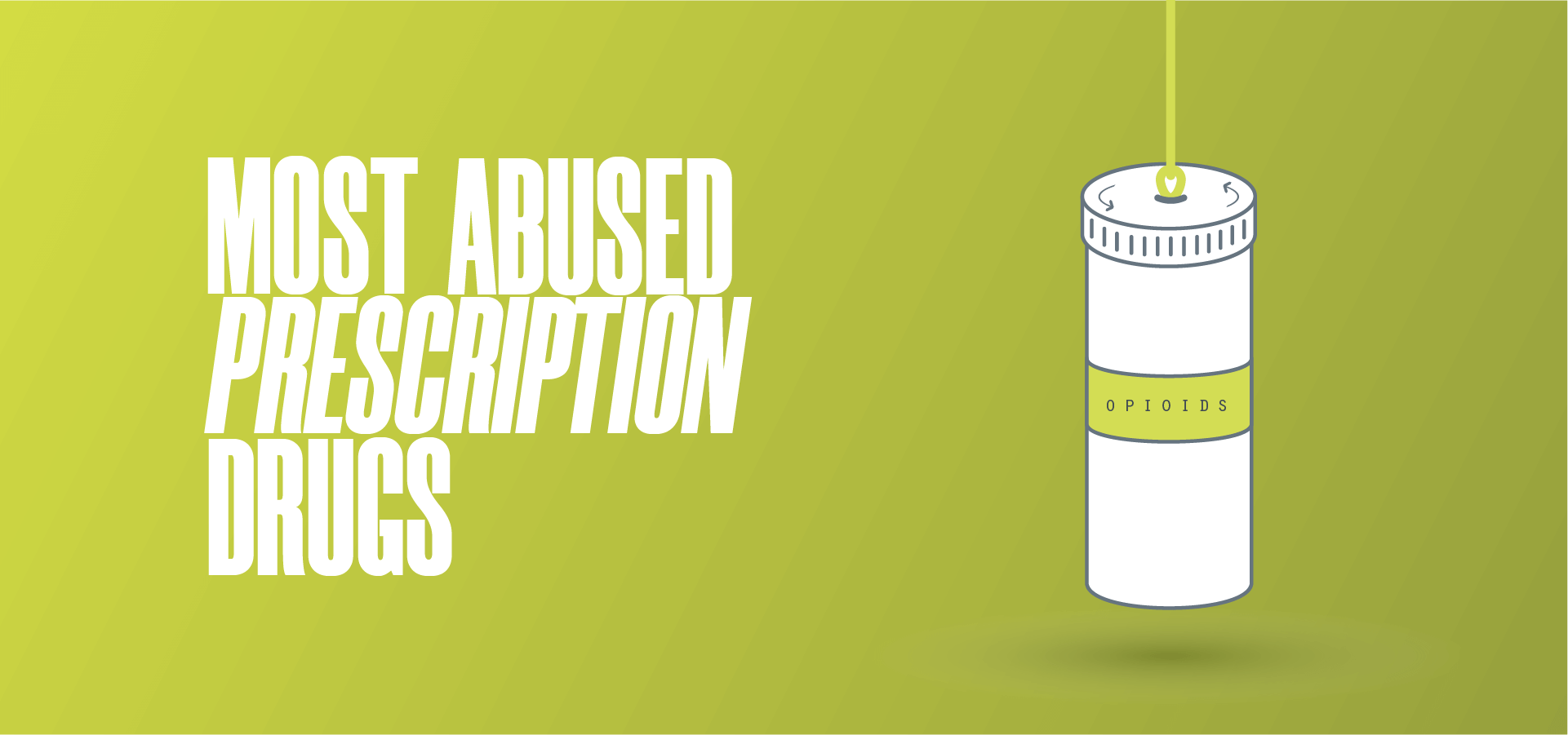
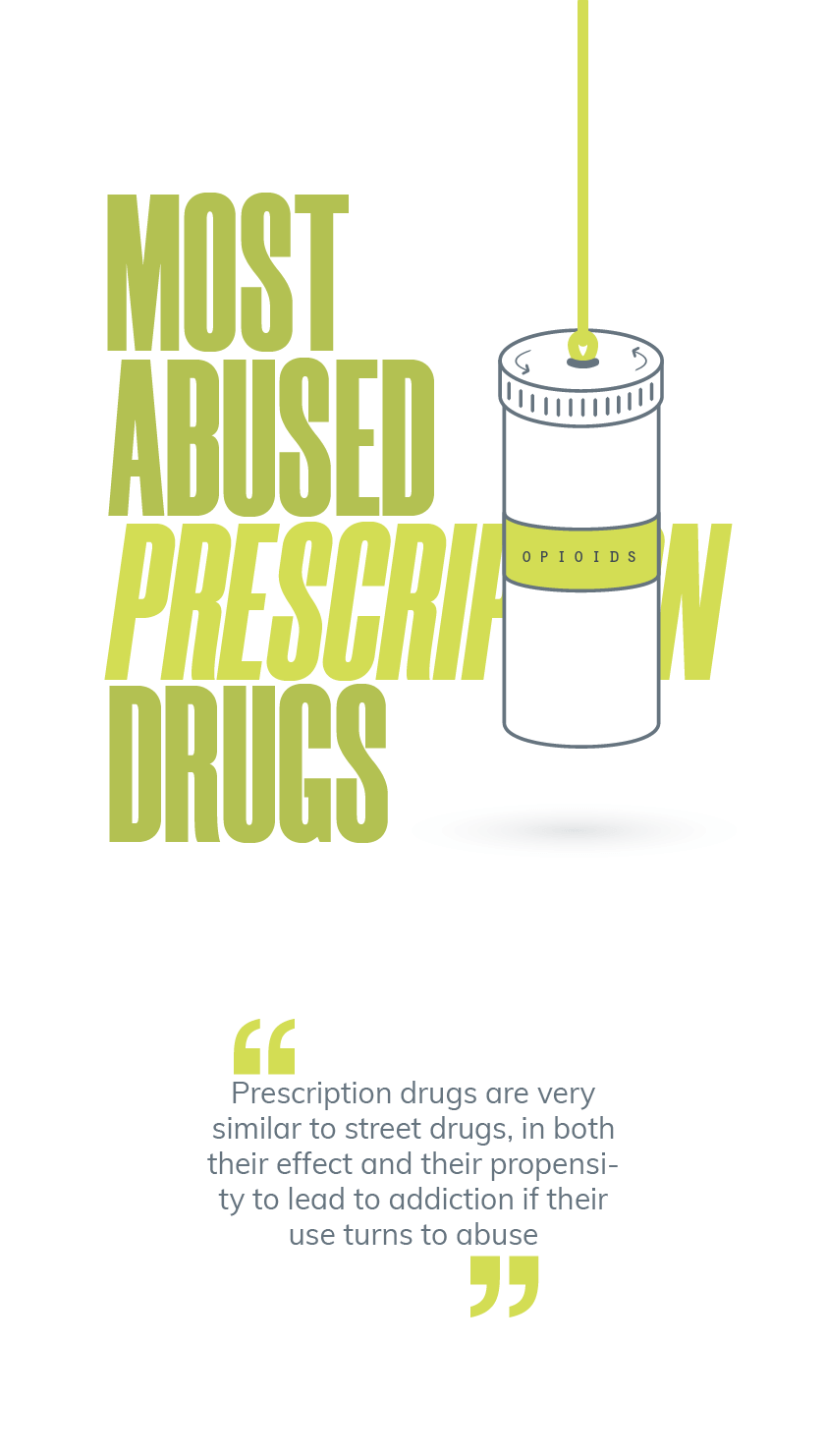
Disclaimer: This article is not intended as a substitute for the counsel of a qualified physician or licensed therapist. This content should be used for purely informational purposes. Please consult your doctor if you have further inquiries on this subject. We intend to impart the most accurate and recent information but cannot make any guarantees.
If you live in the United States, you cannot help but to know about the opioid epidemic that has been sweeping the country in recent years. Addiction used to be about alcohol and illegal drugs, like heroin, cocaine, and meth. Not anymore.
The face of addiction is changing because continually more people are becoming addicted to prescription drugs, like the opioid-based painkillers that their doctor is prescribing for them. It used to be that a drug user went down to the street to get their high; nowadays, they just need to go to the medicine cabinet in the bathroom.
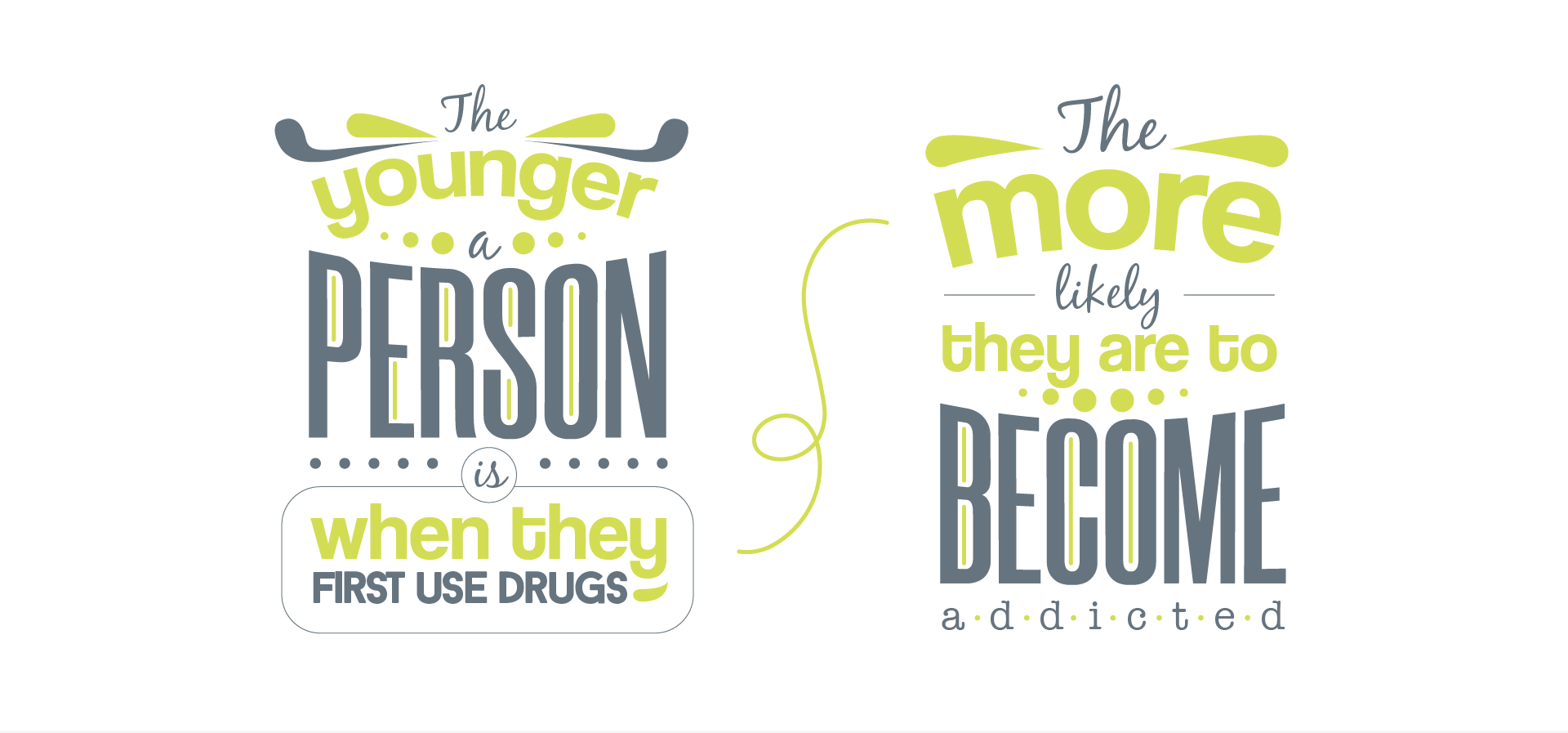
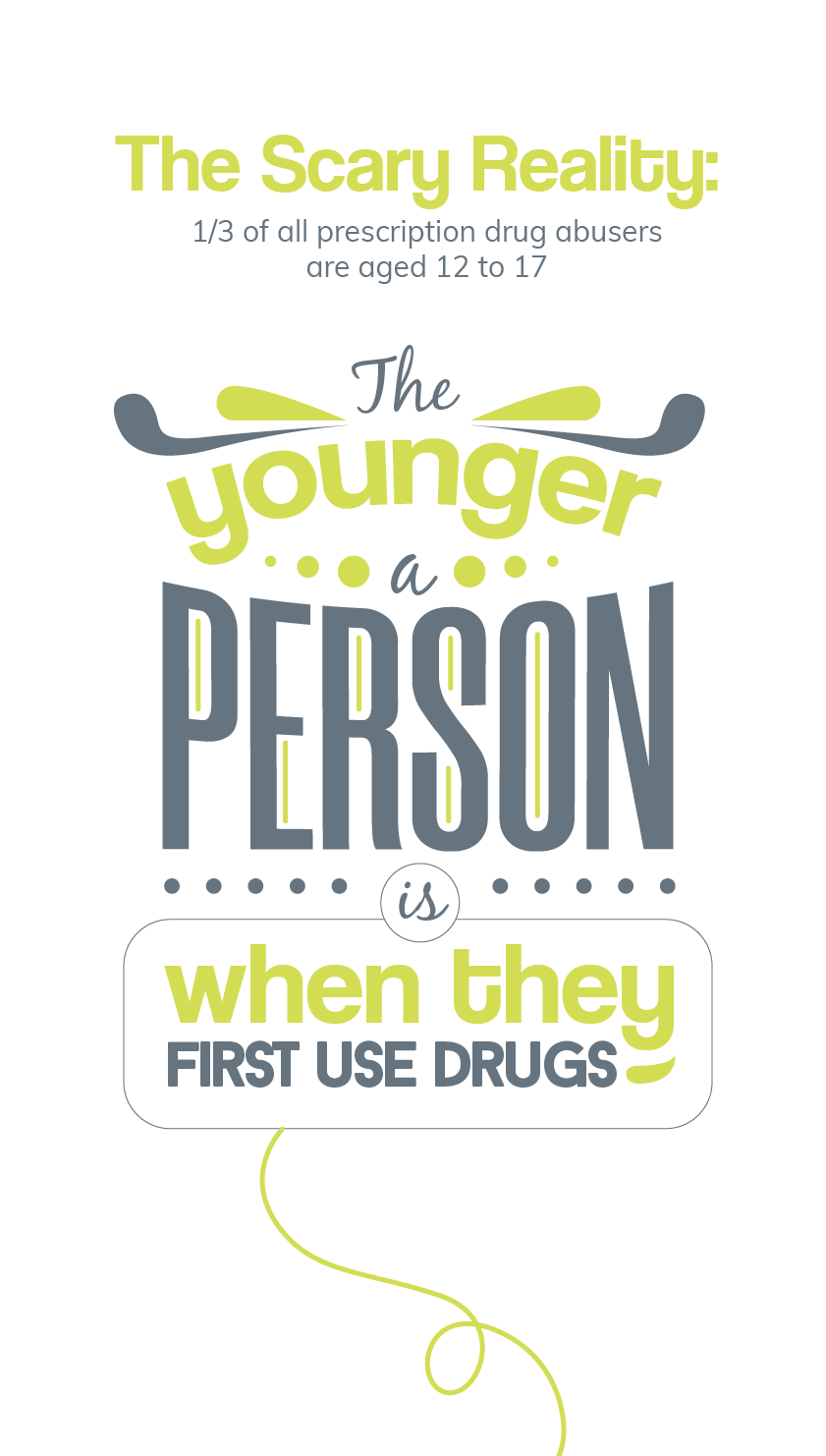
Before we begin our guide to the 15 most abused prescription drugs, it is important to remember that even though addiction is an incurable, chronic disease lasting a lifetime, it is very possible to learn to manage the condition and to live in a healthy lifestyle.
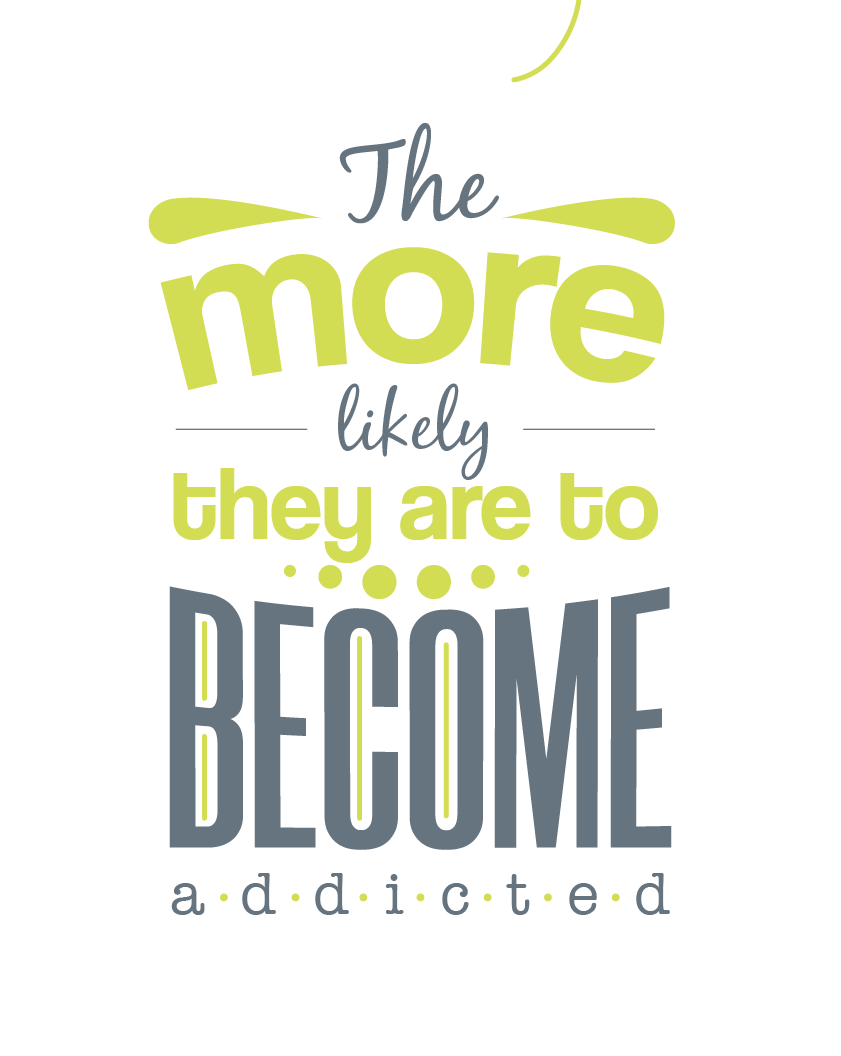
Addiction recovery is no easy task for anyone and can actually prove to be extremely difficult. However, recovery is possible, with millions and millions of ex-addicts as proof; living clean, sober, and happy lives. Yes, there is addiction, but there is always hope and help for those who suffer from it.
Every person taking potentially addictive prescription drugs (particularly opioid-based painkillers, stimulants, or anti-depressants) is at risk of developing a dependence on their medications, thus leading them to addiction.

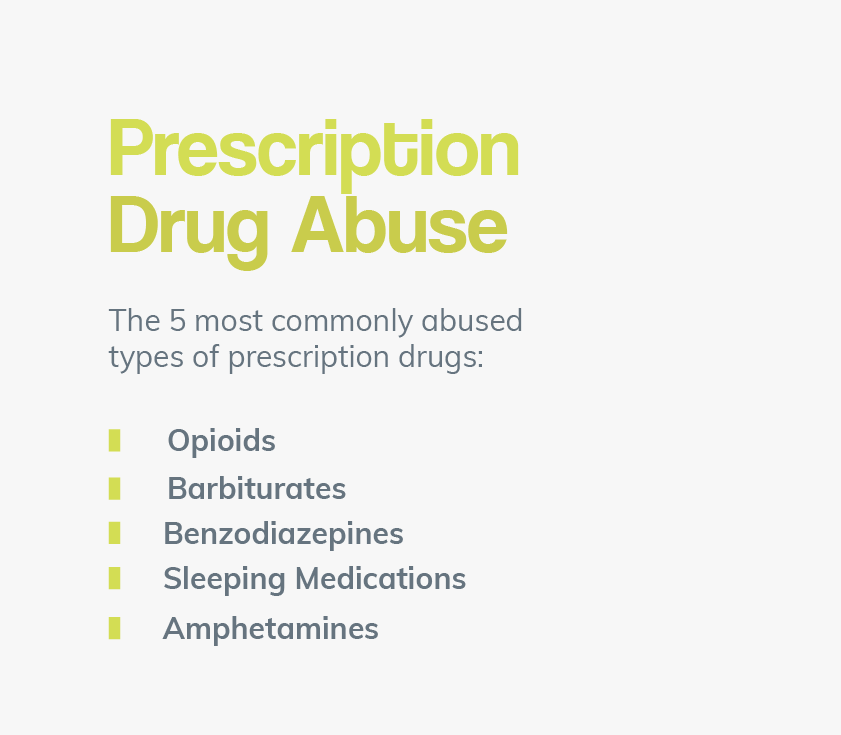
If you're looking for proof that prescription medication addiction really exists, and that it does not discriminate against anyone, rich or poor; it was only two years ago that Prince died of a lethal cocktail of the following prescription medications:
The deadly combination of opioid-based drugs is the fatal factor here; 98% of all fatal overdoses involve the use of more than one substance. This is known as polydrug abuse.
Remember, just because a drug is legal doesn't mean that it is safe, and it doesn't care if you're a college kid, a stressed mom, a senior citizen, or an overworked businessman. Everyone is fair game when it comes to addiction.
It is important to know that prescription drugs are very similar to street drugs, in both their effect and their propensity to lead to addiction if their use turns to abuse. For example, Adderall - a central nervous system stimulant for treating ADHD (Attention Deficit Hyperactivity Disorder) and in wide use by college kids as a "study buddy" to aid concentration - is highly similar to methamphetamine.

In fact, (and this statistic is one of the most seriously alarming of all) ⅓ of all prescription drug abusers are aged 12 to 17 - teenagers and children. Furthermore, research clearly shows that the younger a person is when they first use drugs, the more likely they are to become addicted.
In today's world, teenagers have more access to both legal and illegal drugs than ever before. If they want to get hold of some pills to take to a party, they can usually just raid their parents' and grandparents' medicine cabinets.
"One-third of all prescription drug abusers are aged 12 to 17 - teenagers and children."
As another example, OxyContin - the most abused prescription drug today and #1 in our guide - is highly similar to heroin; so much so that when people addicted to Oxycontin are unable to access any more, many will turn to buying heroin on the street.
Today in the U.S., prescription drug abuse has surpassed car crashes as the leading cause of accidental deaths. Sadly, many loved ones, parents, and friends do not know the signs and symptoms of prescription drug abuse to look out for.
This guide to the 15 most abused prescription drugs will not only tell you what to look out for in cases of possible prescription drug abuse; it will also provide information on the drugs themselves, what kind of drugs they are, what withdrawal symptoms they can cause, what happens in the case of an overdose, and how treatment can provide the answer to a healthy life in recovery.
Prescription drugs can be categorized into types, such as painkillers, sedatives, and stimulants. These are the five most commonly abused types of prescription drugs
Opioid-based painkillers like OxyContin, codeine, and morphine are very effective, working quickly to bring relief to the sufferer. However, if the dose taken is too strong, it can cause the user to feel high, experiencing feelings of euphoria, tranquility, and relaxation. Because of this, addiction can happen quickly, as the user attempts to experience the high repeatedly. In fact, as mentioned earlier, if the user can no longer access the opioid painkiller because their prescription has run out, they will try to source alternatives, and for some, that means buying heroin or similar substances from the street.
How do they work? Opioid drugs work by affixing themselves to certain receptors in the brain, in the spinal cord, and in other areas of the body. They affect the way pain messages are sent to the brain and so reduce feelings of pain in the patient.
Barbiturates, like phenobarbital, secobarbital, and pentobarbital, are strong sedatives that are prescribed for people with anxiety or insomnia, and may even be given to patients who suffer with seizures. Effective as they are, they can be dangerous if a higher dosage than the one prescribed is taken or if they are mixed with alcohol. Addiction can occur if they have been taken for too long or if they are no longer needed.
These prescription drugs, often called "benzos," are prescribed to help with anxiety and sleep problems. Although they aren't as dangerous as barbiturates, they are highly addictive if the user takes them for too long. Because of the severe withdrawal symptoms, physical dependence can occur quickly. Common examples of benzos that are commonly abused include Xanax and Valium.
Insomnia can cause many problems in an individual's life and naturally, those who suffer with it turn to their doctors to provide relief. However, such medications, like Ambien, are only required for a short time. Problems occur when the patient begins to believe they cannot sleep without taking them, and so abuse and then addiction can follow.
These prescription drugs, such as Adderall, are given to sufferers of conditions such as ADHD. They are categorized as stimulants and work well because they boost alertness and helps users to focus. Additionally, amphetamines provide a burst of energy, and they can even help with weight loss.
It is for these very same reasons that amphetamines are commonly abused, causing addiction. In particular, the abuse of Adderall, also known by users as a 'study buddy', is mostly exclusive to the school and college generation, because its effects boost a student's ability to study and concentrate longer.
If you are aware of the U.S. opioid epidemic, you will also be aware of the drug most associated with the crisis - oxycodone, branded and sold as OxyContin.
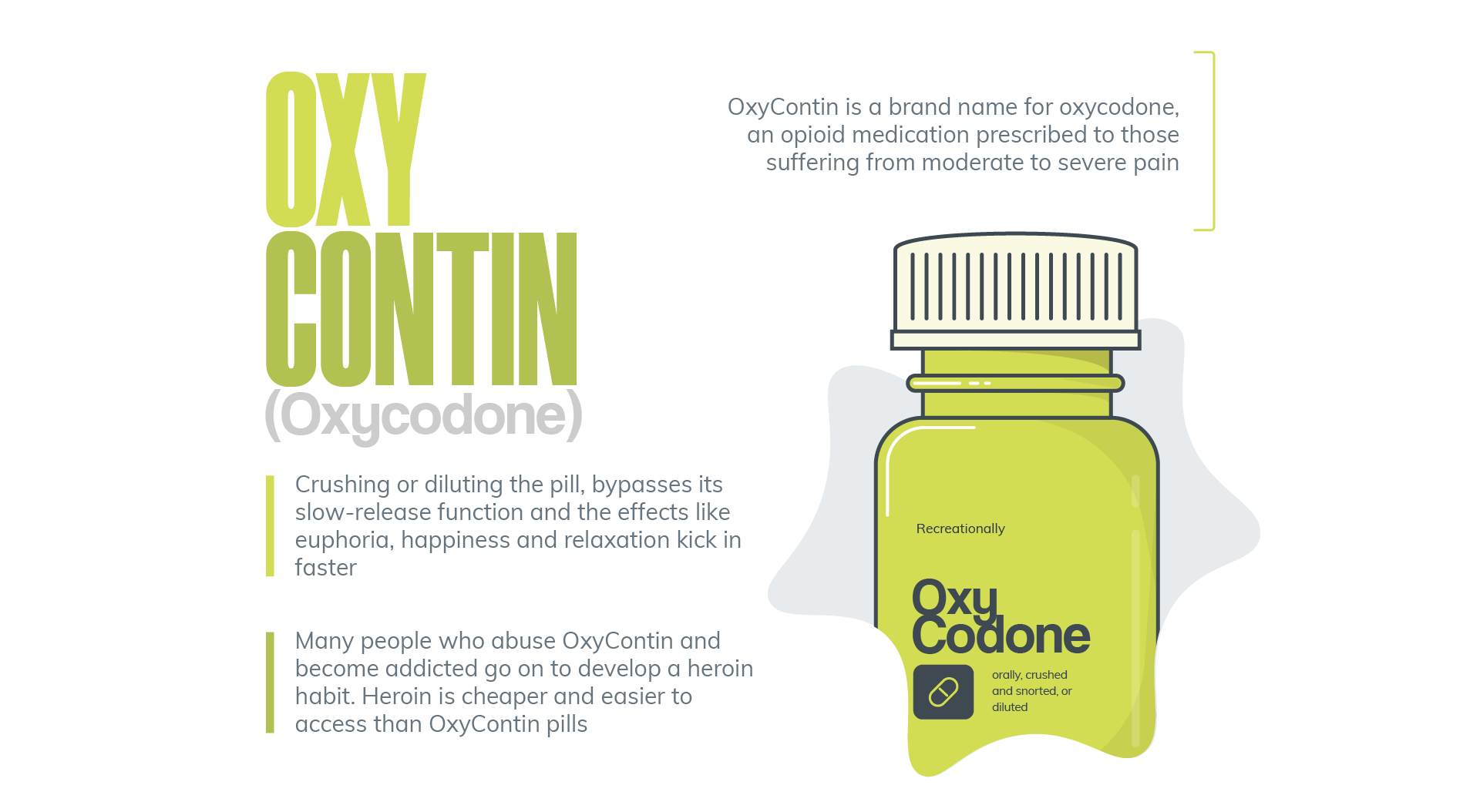
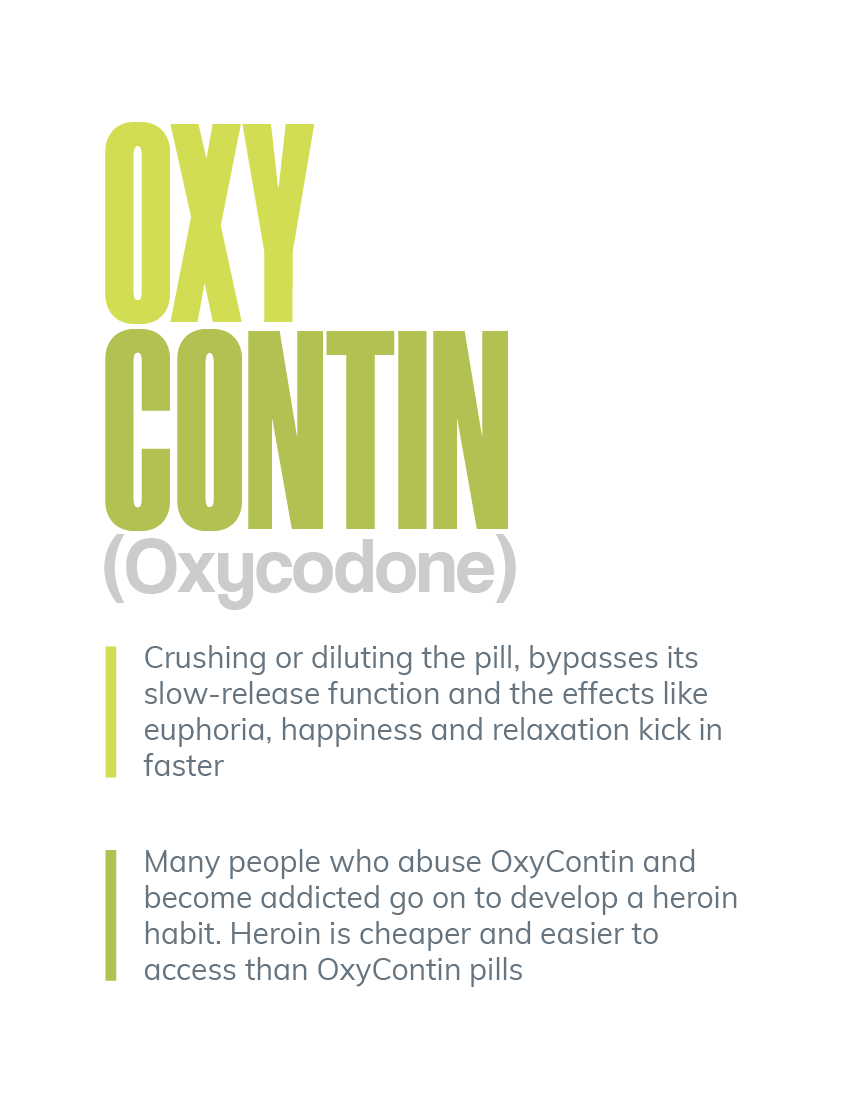
When the pharmaceutical companies launched this new painkiller in 1996, aimed at those suffering from moderate to severe pain, they marketed OxyContin to both the prescribing doctors and the patients who would be taking it as a slow-release tablet that was resistant to abuse.
Time, however, has proven it be anything but. OxyContin is shown to be highly addictive with extremely severe opioid withdrawal symptoms, thereby increasing the likelihood of addiction, and has clearly had a severe impact on U.S. society today.
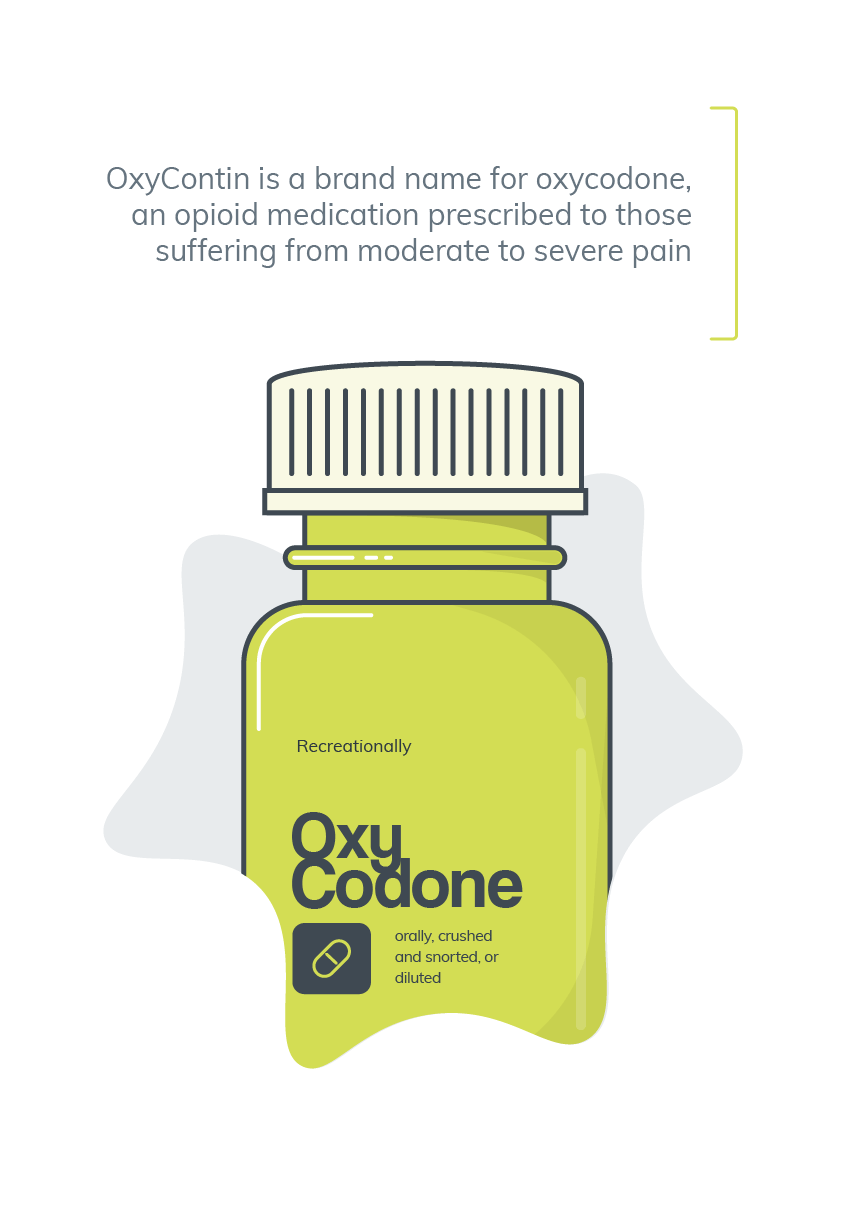
Classed as a Schedule II drug by the DEA, U.S. government statistics are now showing a gradual reduction in the number of opioid prescriptions being dispensed year-by-year. The peak came in 2012, when a colossal 255,207,954 of them were dispensed at a rate of approximately 81 to every 100 people.
Dependence upon any prescription drug can occur if the dosage is increased by the patient because a tolerance has built up over time. A knock-on effect of this is that the patient's prescription will not last the designated time period, so they will seek to access other sources of the drug, or even substitutes, that provide the same effect. One of these substitutes is heroin.
Recreationally, OxyContin is taken either orally, crushed and snorted, or diluted in water and then injected. By crushing or diluting the pill, the slow-release function is bypassed, and the effects, such as euphoria, happiness and relaxation are rapid. However, many people who abuse OxyContin become quickly addicted and go on to develop a heroin habit; heroin is cheaper and easier to access than OxyContin pills.
Street names for Oxycodone include:
Oxycodone, the active chemical ingredient in OxyContin, is also used in Percocet (featured later in this list) and also in a fast-acting liquid form that goes by the brand name OxyDose. OxyDose is designed for 'breakthrough pain' - pain that has not been affected by other painkillers. It's normal side effects include dizziness, sleepiness, and confusion; but when abused it can cause respiratory problems and even death.
Once a dependence to OxyContin has developed, withdrawal symptoms may include:
Hydrocodone, the primary ingredient in Vicodin, another opioid-based painkiller, is a semi-synthetic opioid made from codeine. It is also made from the opium poppy, like heroin. "Semi-synthetic" means that hydrocodone is a mixture of natural compounds and those that are manufactured exclusively in a laboratory.
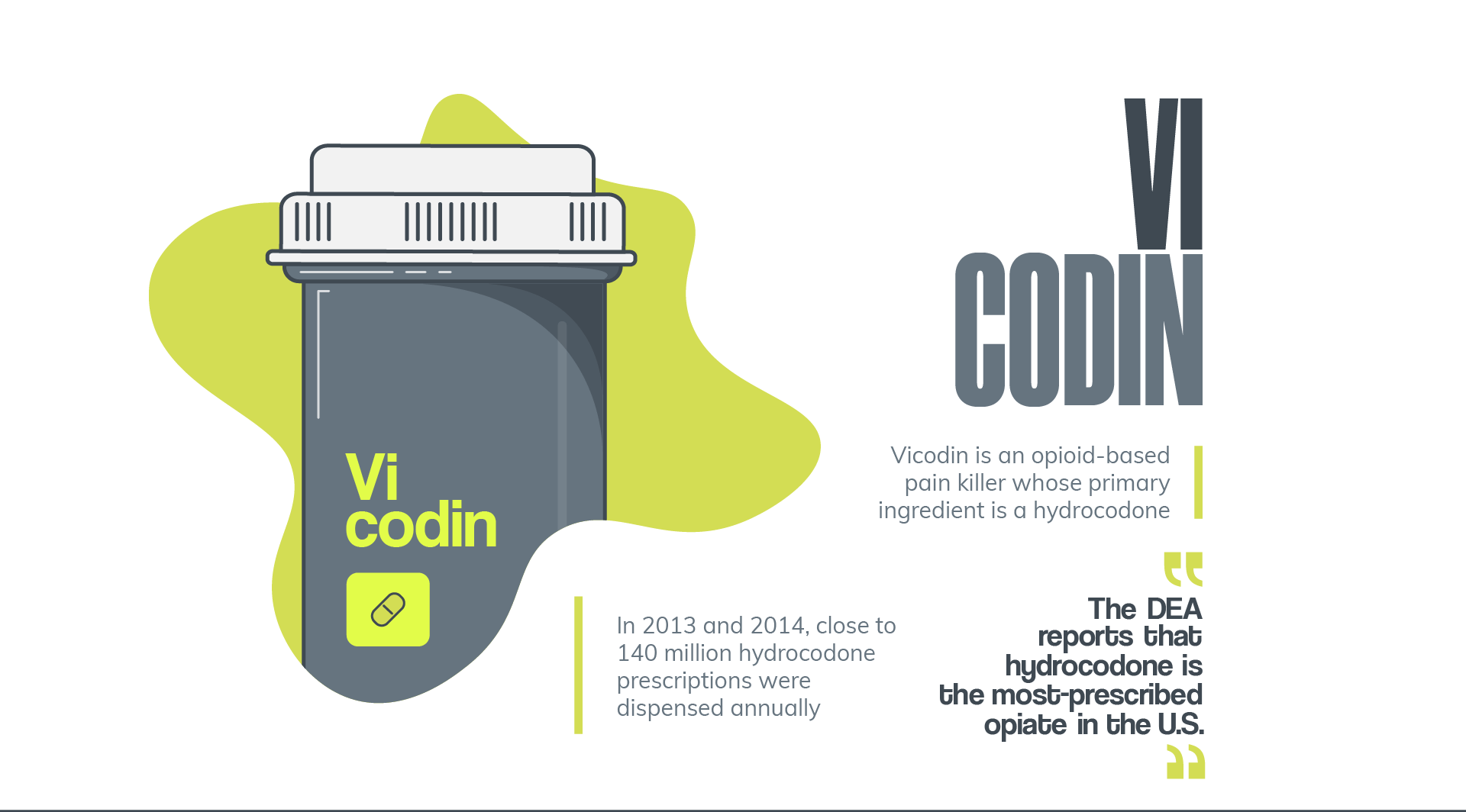
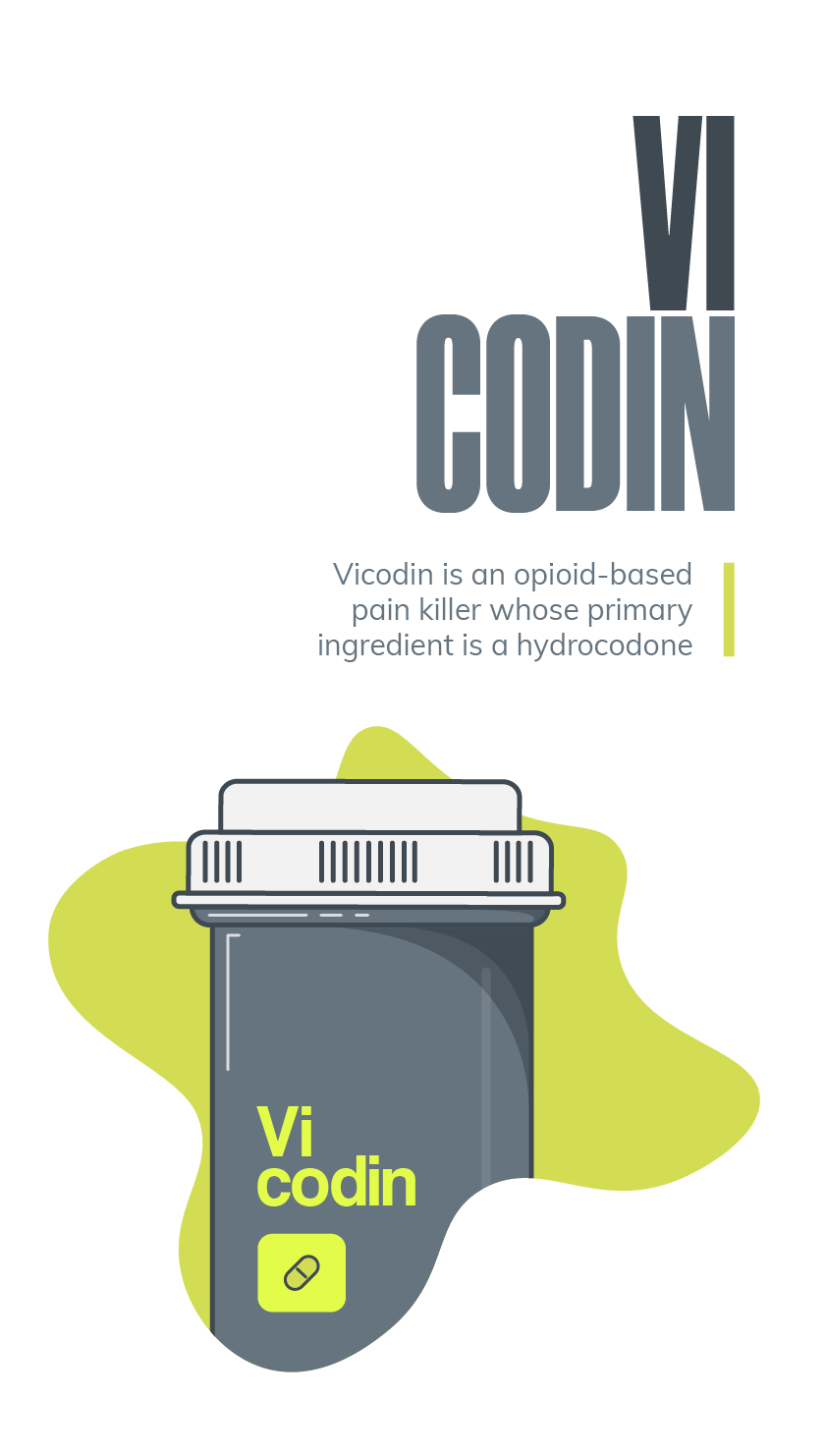
Hydrocodone is prescribed for the treatment of moderate to severe pain, or as a cough suppressant. Although hydrocodone is only 59% as potent as morphine, the two drugs are roughly equivalent at reducing pain when taken orally. When compared to OxyContin, it has been found in ER patients with broken bones that the two are again roughly the same. However, as a cough suppressant, hydrocodone is stronger and more effective than codeine.
Because it can be found in a number of different prescriptions, the DEA reports that hydrocodone is the most-prescribed opiate in the U.S. In 2013 and 2014, close to 140 million hydrocodone prescriptions were dispensed annually. However, like other opioid-based prescriptions, the possibility of abuse is high. In fact, the National Survey on Drug Use and Health says that over 24 million Americans have used hydrocodone non-medically. In other words, recreationally. Should users be unable to access hydrocodone, they may turn to heroin.
Again, like other opioid medications, hydrocodone comes with numerous side effects, such as:
Hydrocodone withdrawal symptoms include:
If hydrocodone, a central nervous system (CNS) depressant, is used recreationally with other substances, its dangers magnify greatly. Other substances that should be avoided include:
Using hydrocodone with alcohol or any of these other medications can magnify CNS depression, potentially leading to death:

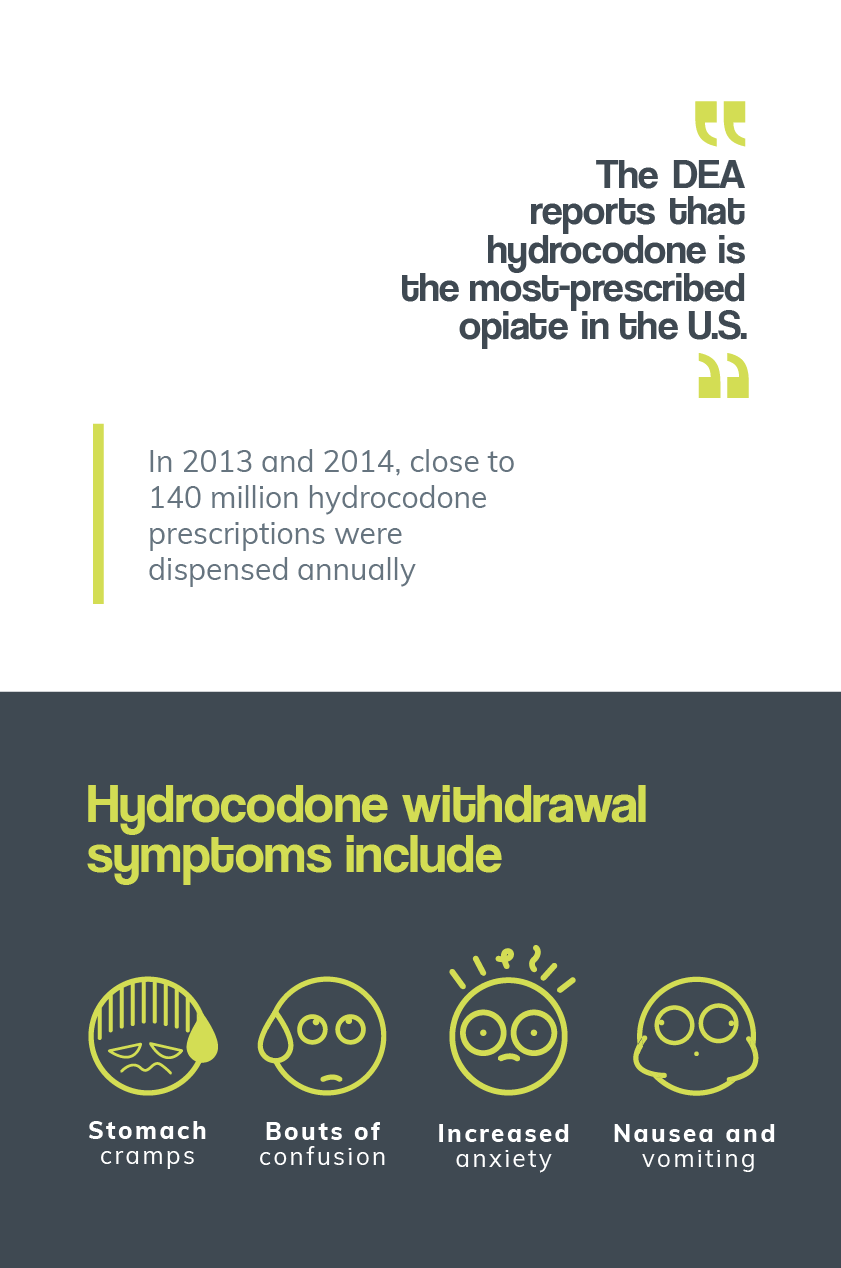
Hydrocodone overdose victims typically die from respiratory depression - they choke to death because they can't get enough oxygen to supply the demands of their brain, major organs, and bodily systems. However, it's important to remember that people do not normally die immediately during a hydrocodone overdose. In fact, overdose is progressive, taking between one and three hours. Put simply, there still may be time to save their life if the proper measures are taken.
Celebrities who have suffered from hydrocodone addiction include Jamie Lee Curtis, George Carlin, Matthew Perry and Eminem. The overdose death of Heath Ledger was, in part, attributed to hydrocodone.
The actual pills go by many names on the street, including:
Codeine, prescribed only for mild to moderate pain, makes up the third spot in our list alongside other opioid-based painkillers. However, do not be fooled by the fact it's not as strong as some other prescription opioids; heroin users unable to get their normal fix sometimes use codeine as a temporary substitute. As with all opioids, if the dosage is increased above the prescribed measure, the effects of euphoria and relaxation will also increase. Codeine is abused recreationally in tablet form as well as in cough syrup medications.
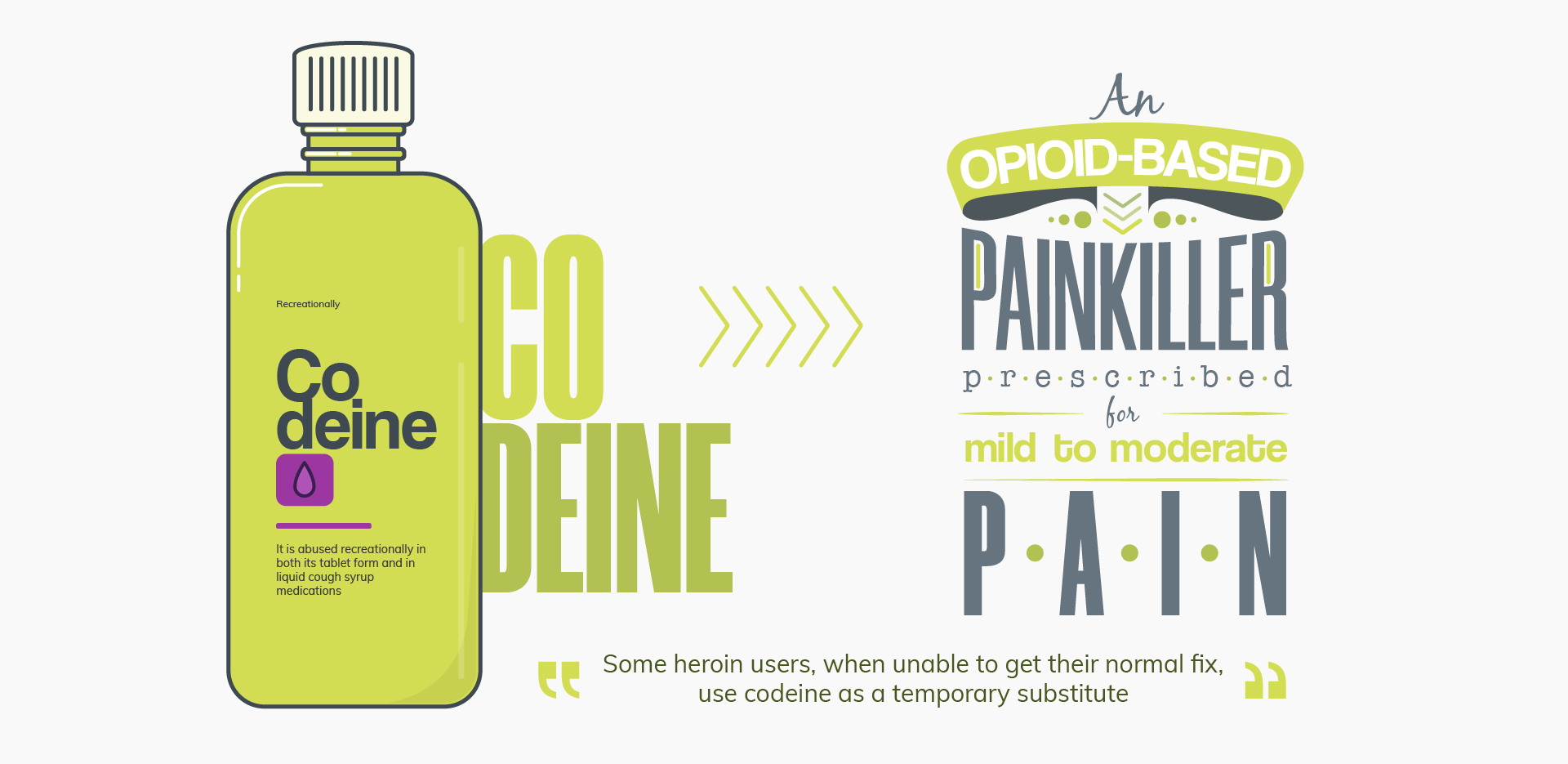
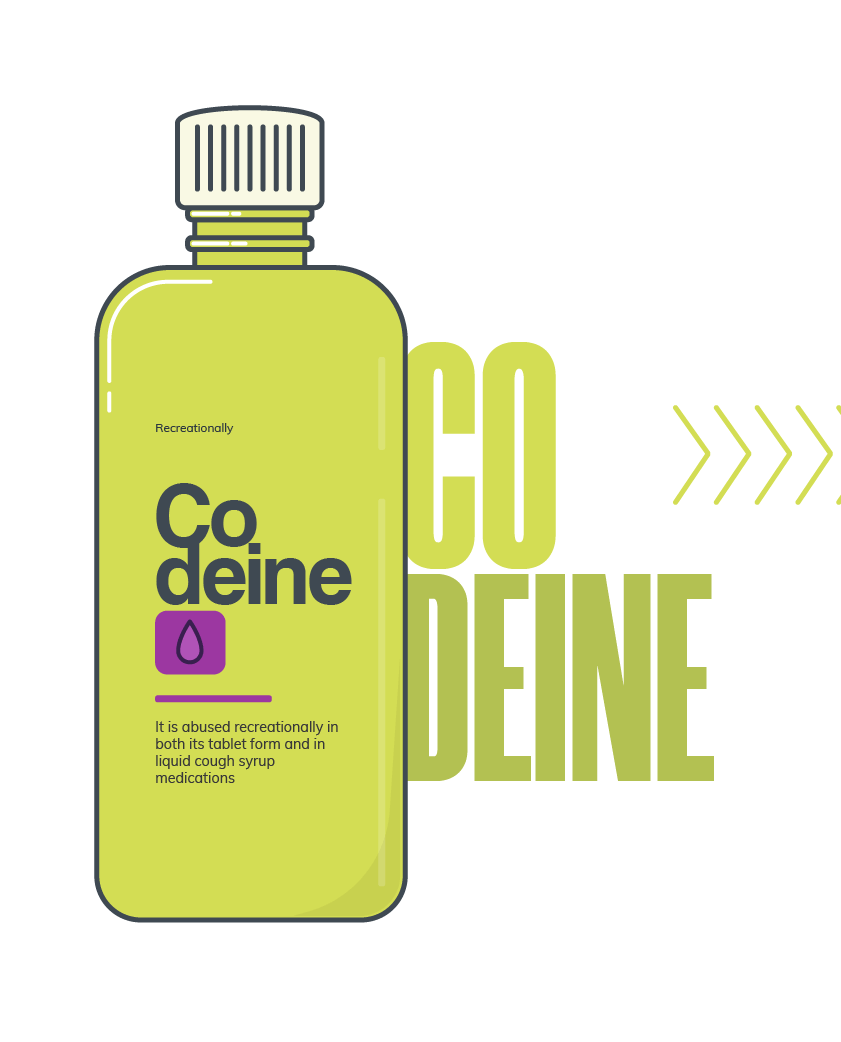
Prescription-strength codeine-based cough syrups, therefore, place codeine within the reach of children and teenagers, as the vast majority of parents will simply place an opened bottle in their medicine cabinets. It has even acquired a kind of cult status among the hip-hop crowd and goes by the slang name "lean" when it is mixed with fizzy drinks and hard candy.
These homemade concoctions may appeal to youngsters, but many aren't aware they've actually created a powerful narcotic drug. Lean, also known as purple drank, purple lean, sizzurp, and dirty sprite, can result in seizures, respiratory depression, memory loss, and death by overdose.
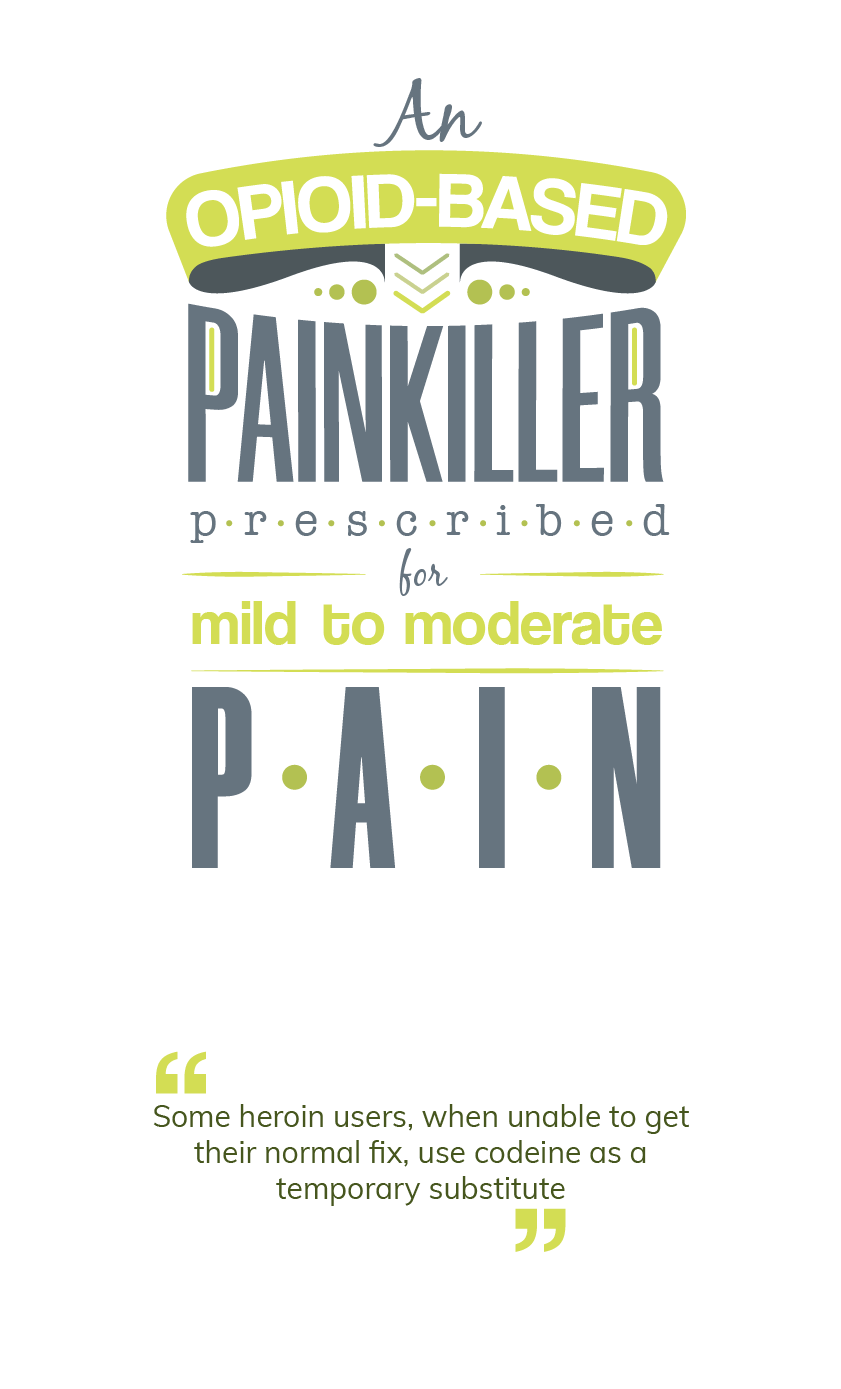
If that is not concerning enough, codeine is also the main constituent of an incredibly powerful synthetic opioid called desomorphine. Desomorphine, known for the sheer speed of its powerful effect, has been used for sedation and anesthesia in Switzerland. Since then, it comes almost exclusively from illegal drug labs and is made using codeine and a combination of other chemicals.

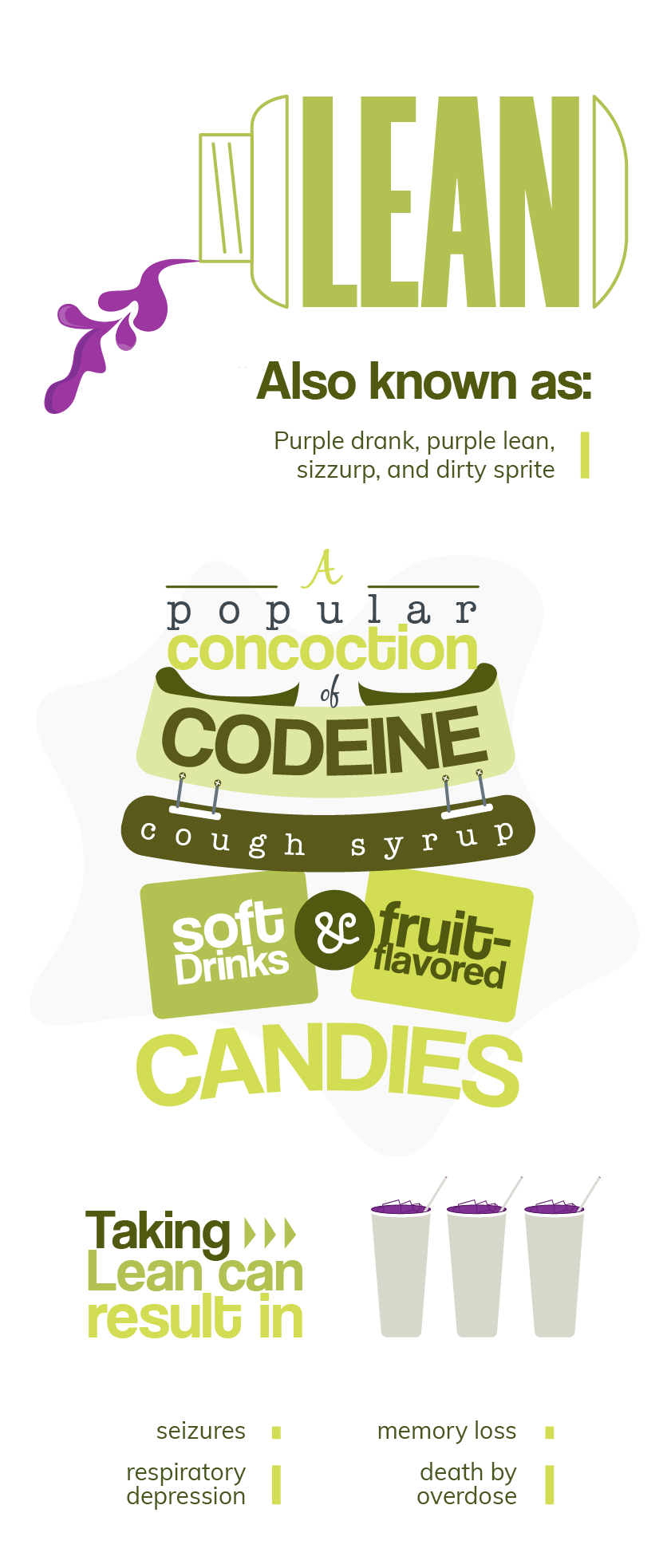
Codeine is a controlled substance in the U.S. but can be acquired over-the-counter in other countries. Since the street version of the drug comes from illegal labs, it is rarely pure. This contamination can have horrible effects on users, rotting flesh and causing severe infections. Most desomorphine users inject the drug.
The slang names for this drug come from the appalling physical and mental effects it has on users, including:
Common physical symptoms of codeine withdrawal last around 8 days and, on their own, are not life-threatening. However, the psychological symptom of depression can last for many months:
All of the prescription drugs featured in this list can be abused by children, teenagers, young adults, middle-aged people, and senior citizens, sometimes with fatal results. Adderall, however, is prescribed, used, and most often abused almost exclusively by teenagers and college students. It is an amphetamine, a central nervous system (CNS) stimulant, and is prescribed for ADHD (Attention Deficit Hyperactivity Disorder) and narcolepsy, a sleep disorder.
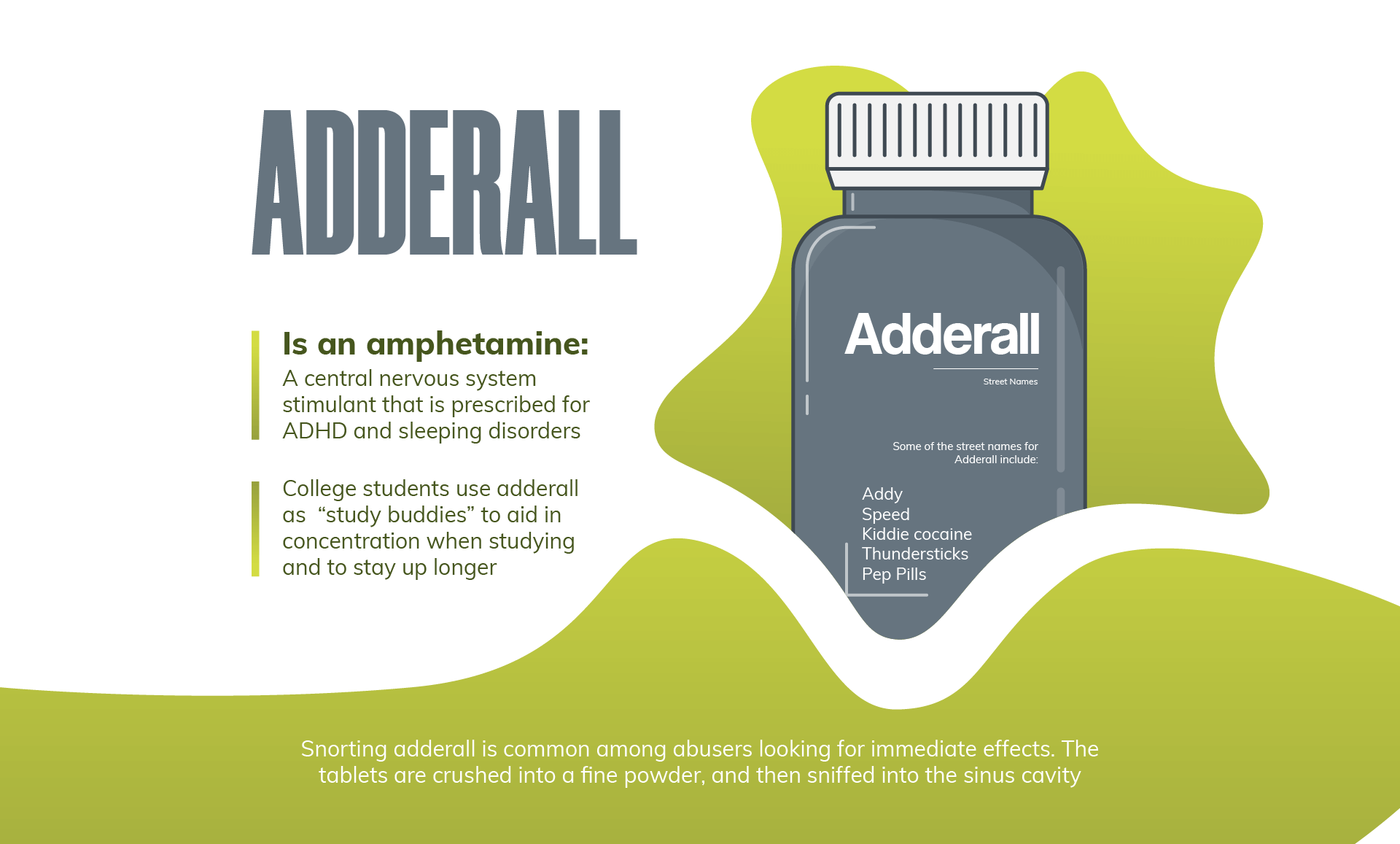
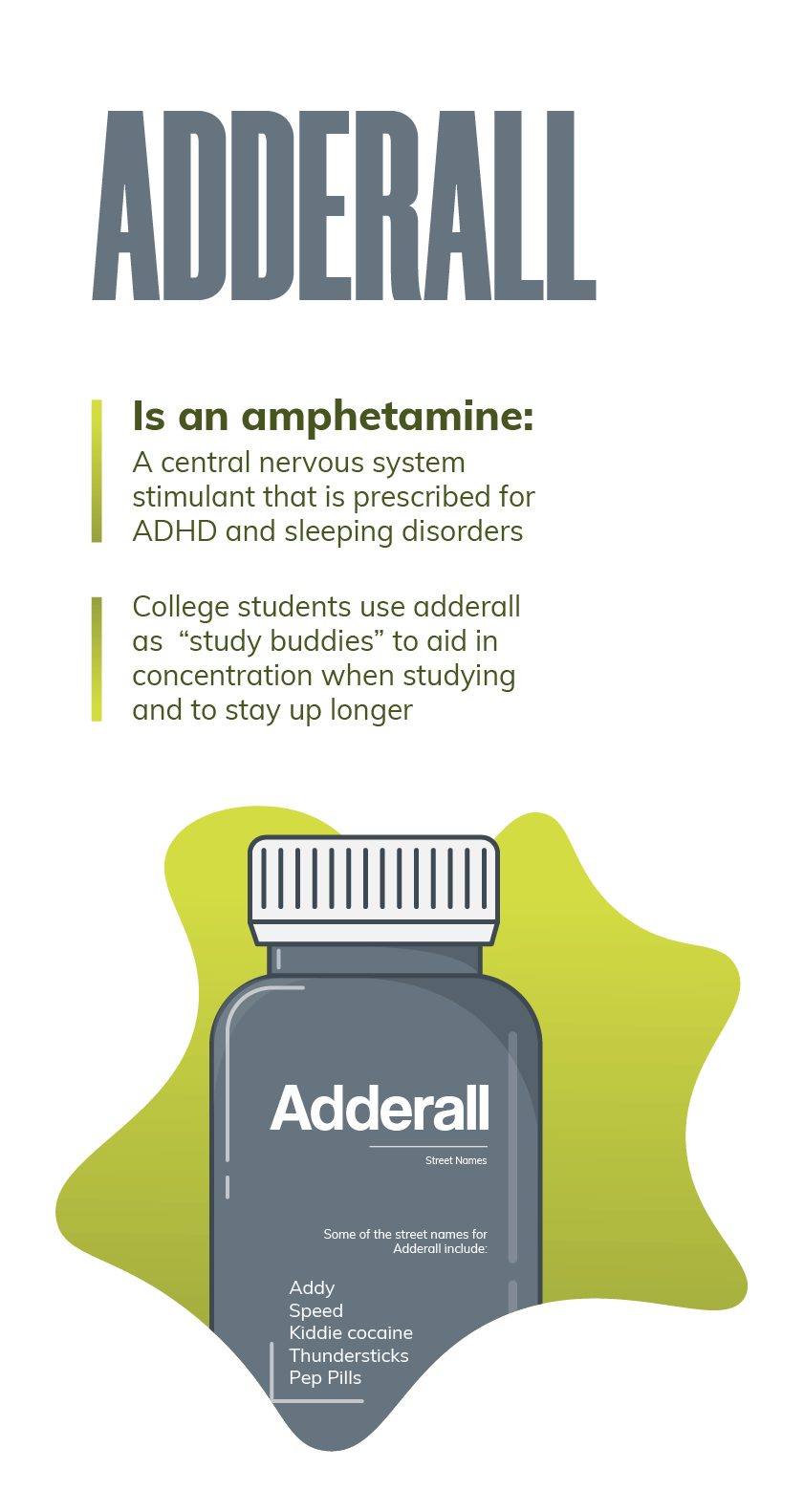
According to IMS Health, 16 million prescriptions were written for Adderall in 2013, which is an increase of three times the number written in 2008. Because it's predominantly prescribed for the younger generation, the possibility of abuse increases; and because of the high energy levels it creates, teenagers and college students are abusing it as a "study buddy" drug to aid concentration either in class or when studying.
Adderall comes in either tablet form, which those who abuse it crush and snort to achieve an instant energy hit, or as an extended-release capsule, which is designed to provide more energy for a longer period of time. As you would expect, it has an established reputation as a party drug, particularly raves.
Some of the street names for Adderall include:
Snorting adderall is common among abusers looking for immediate effects. The tablets are crushed into a fine powder and then sniffed into the sinus cavity. This often leads to a more intense high, but snorting Adderall comes with its own side effects. Snorting any kind of powder made from crushed pills can cause destruction of the nasal and sinus cavities.
The longer someone continues taking Adderall in this way, the more damage will be done. Snorting can also dangerously amplify other Adderall side effects, such as an irregular heartbeat. Obviously, by snorting snorting Adderall, abusers have an increased risk of overdose as well.
Some of the side effects of Adderall abuse and addiction can include:
If someone overdoses on Adderall, they may experience:
This should be of major concern - the fifth most abused prescription drug is the most prescribed psychiatric drug in the U.S. today. Xanax, or alprazolam, is highly addictive to anyone who abuses their medication; strong physical dependence is very common among abusers because the withdrawal symptoms experienced when stopping its use are very severe.
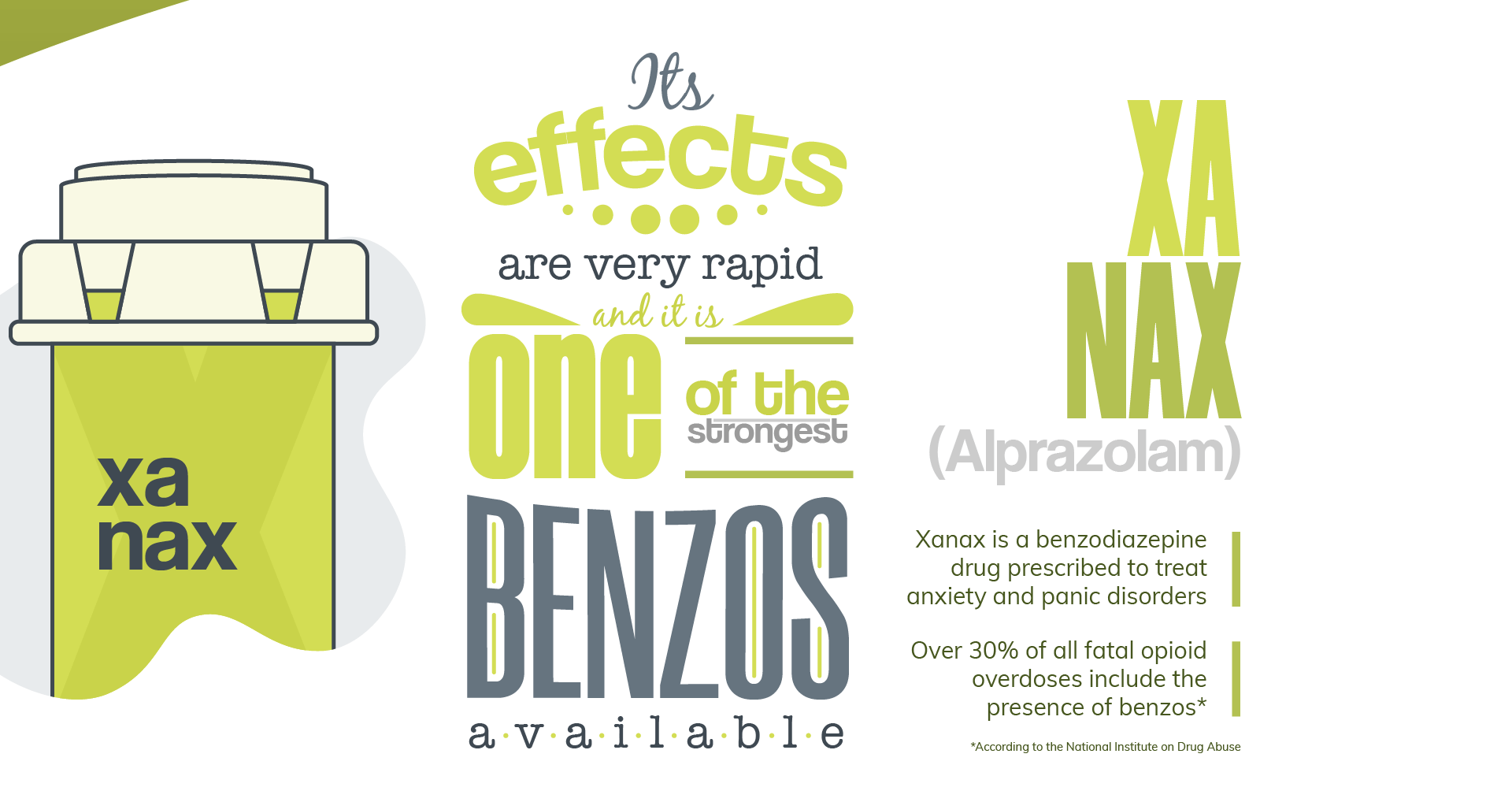
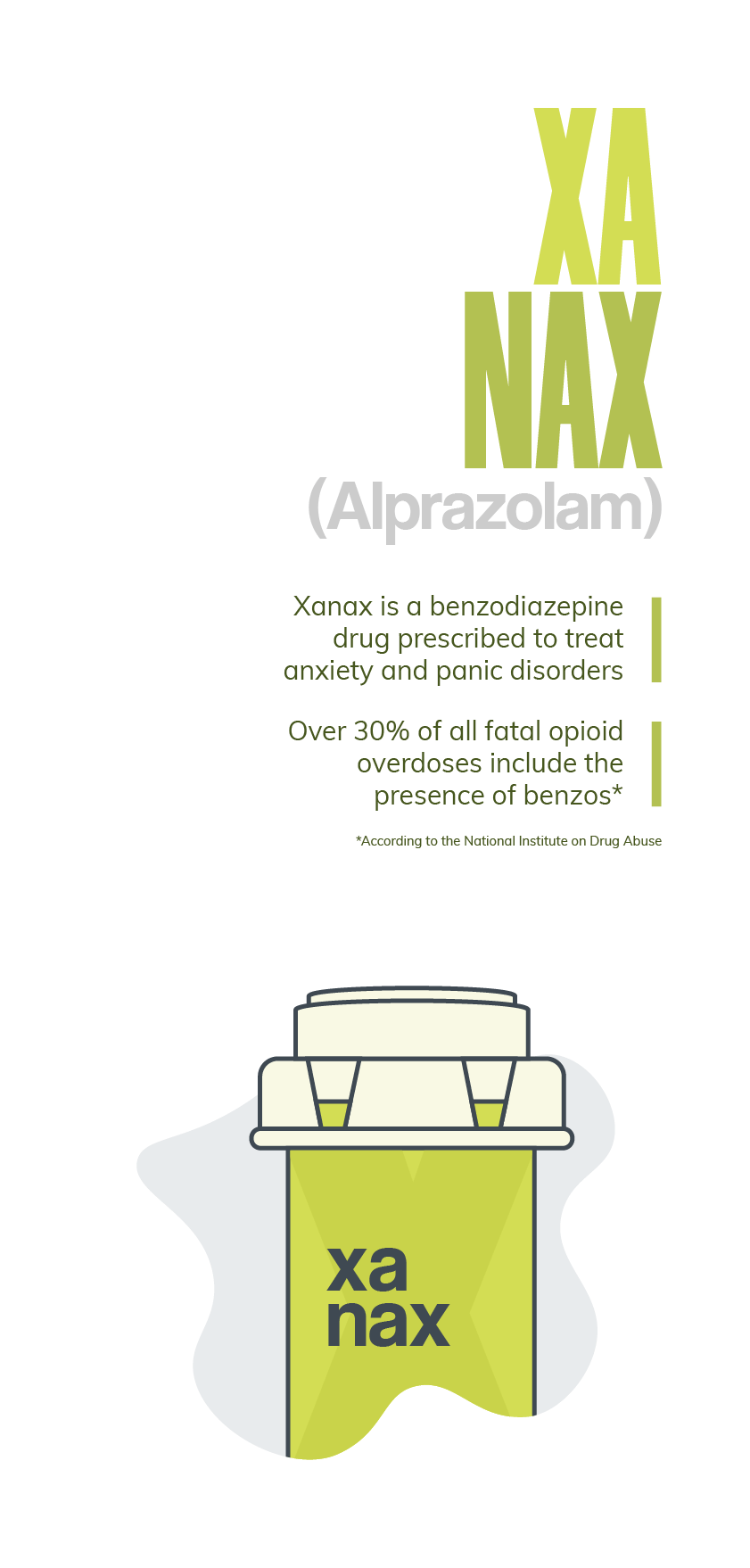
Xanax is prescribed to treat anxiety and panic disorders and is one of the benzodiazepine class of drugs commonly known as "benzos". When taken, its effects are very rapid, and it is one of the strongest benzos available.
When taken alone at a higher dose than has been prescribed, Xanax can be fatal. If that same higher dose is mixed with alcohol or other drugs, the chances of fatality increase even more. Furthermore, its side effects include memory loss, which is worsened if alcohol and/or other drugs are consumed as well. Some abusers mix Xanax with other substances simply to intensify their buzz.
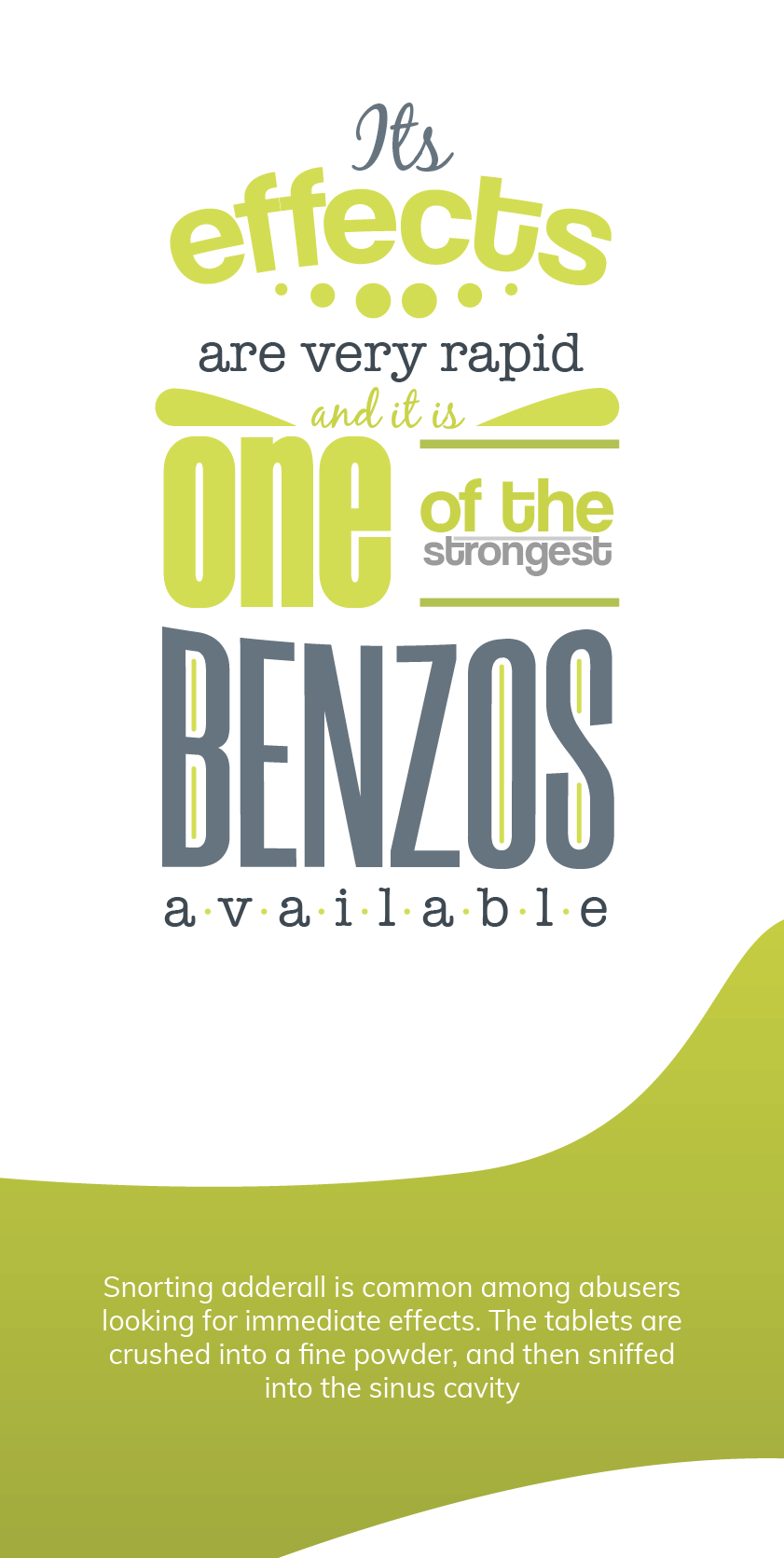
Other side effects of Xanax abuse include:

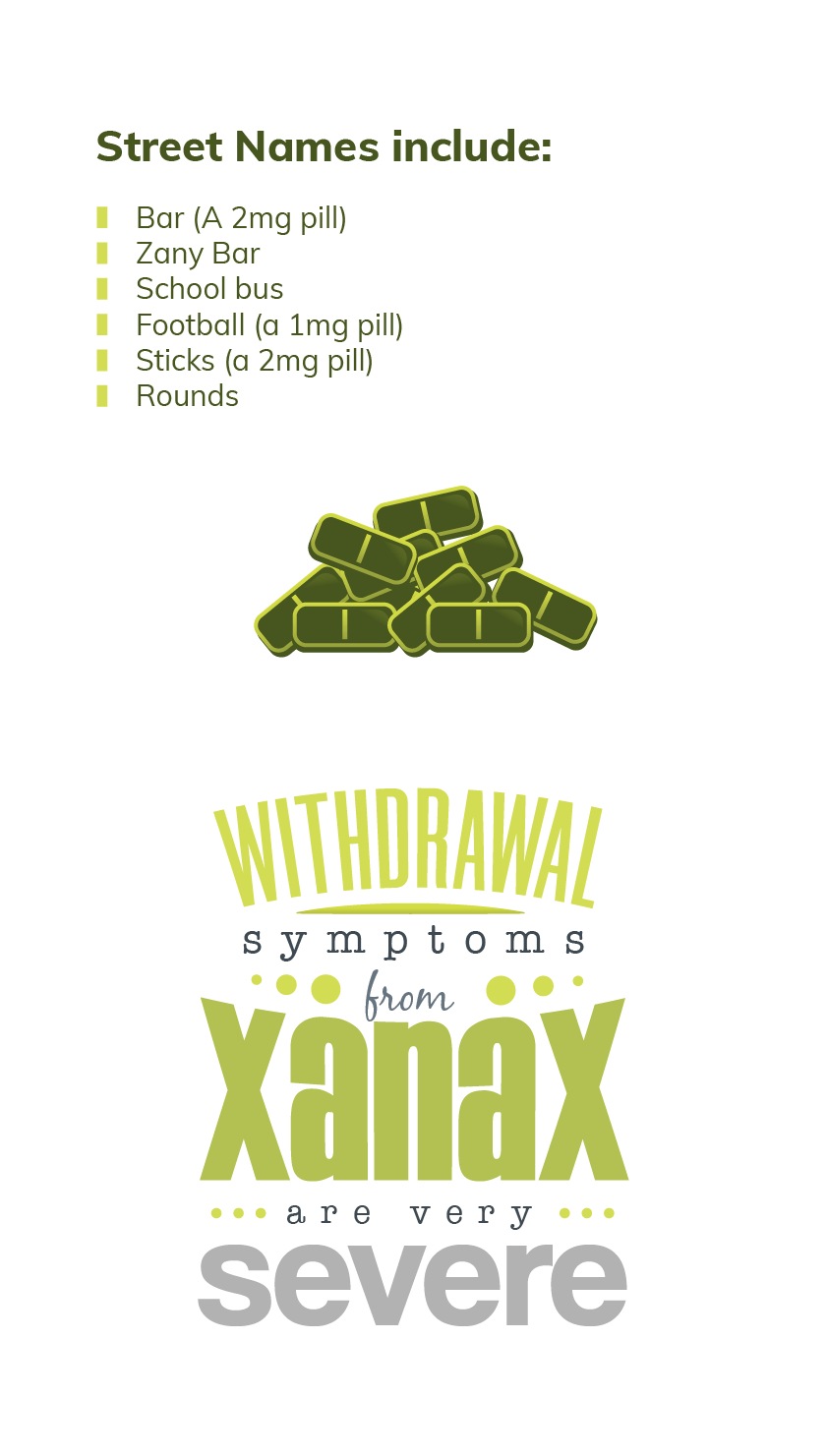
Slang or street terms for Xanax include:
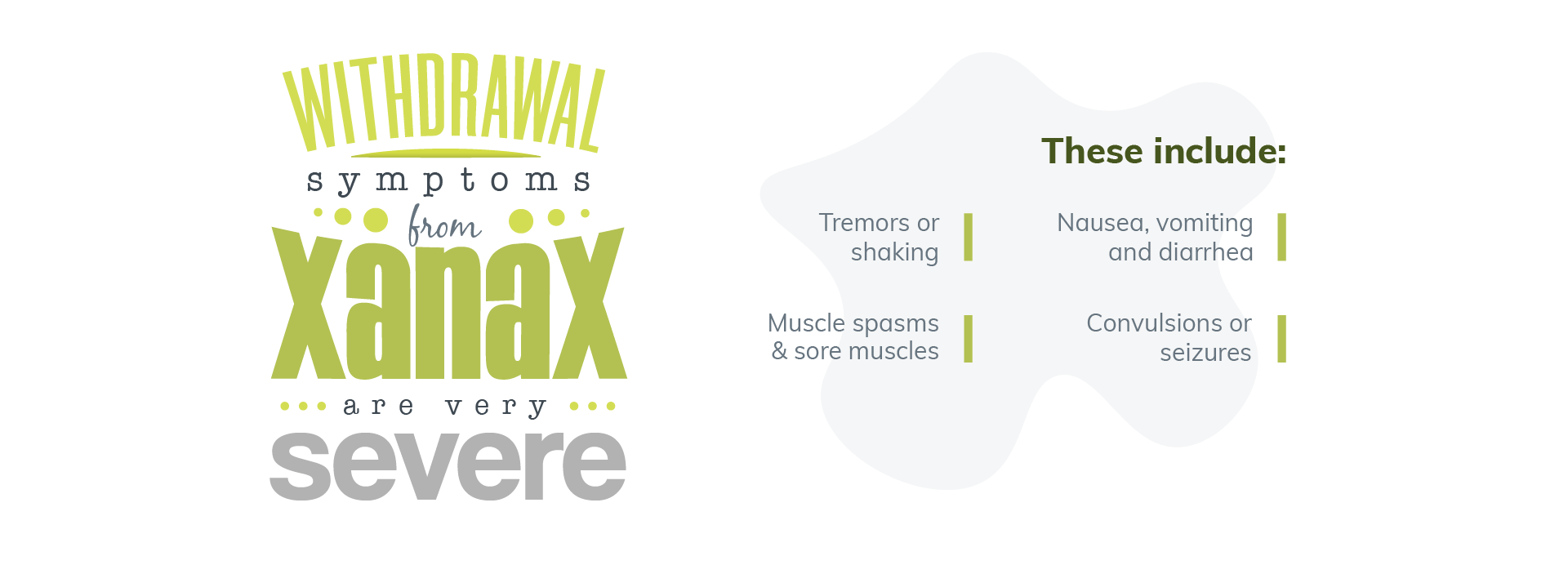
As stated before, the withdrawal symptoms from Xanax are severe, increasing the likelihood of addiction. These include:
Famous celebrities whose deaths have been associated with Xanax and other benzos include Whitney Houston and Heath Ledger. In fact, celebrity addiction to anti-anxiety medications, such as Xanax, is fast becoming a mini-epidemic in itself, with more and more seeking treatment for their addiction. Additionally, according to the National Institute on Drug Abuse, over 30% of all fatal opioid overdoses include the presence of benzos.
An overdose of Xanax may feature many of the symptoms described abovec as well as:
An astonishing 50 to 100 times more powerful than heroin, Fentanyl, proven to be one of the most dangerous opioid painkillers when abused and one of the main reasons there have been so many fatal overdoses during the opioid epidemic, is still available as a prescription drug. It is used specifically for what is termed as 'breakthrough pain' - that is, pain that has not been effectively treated by the current pain-killing or analgesic medication being used.
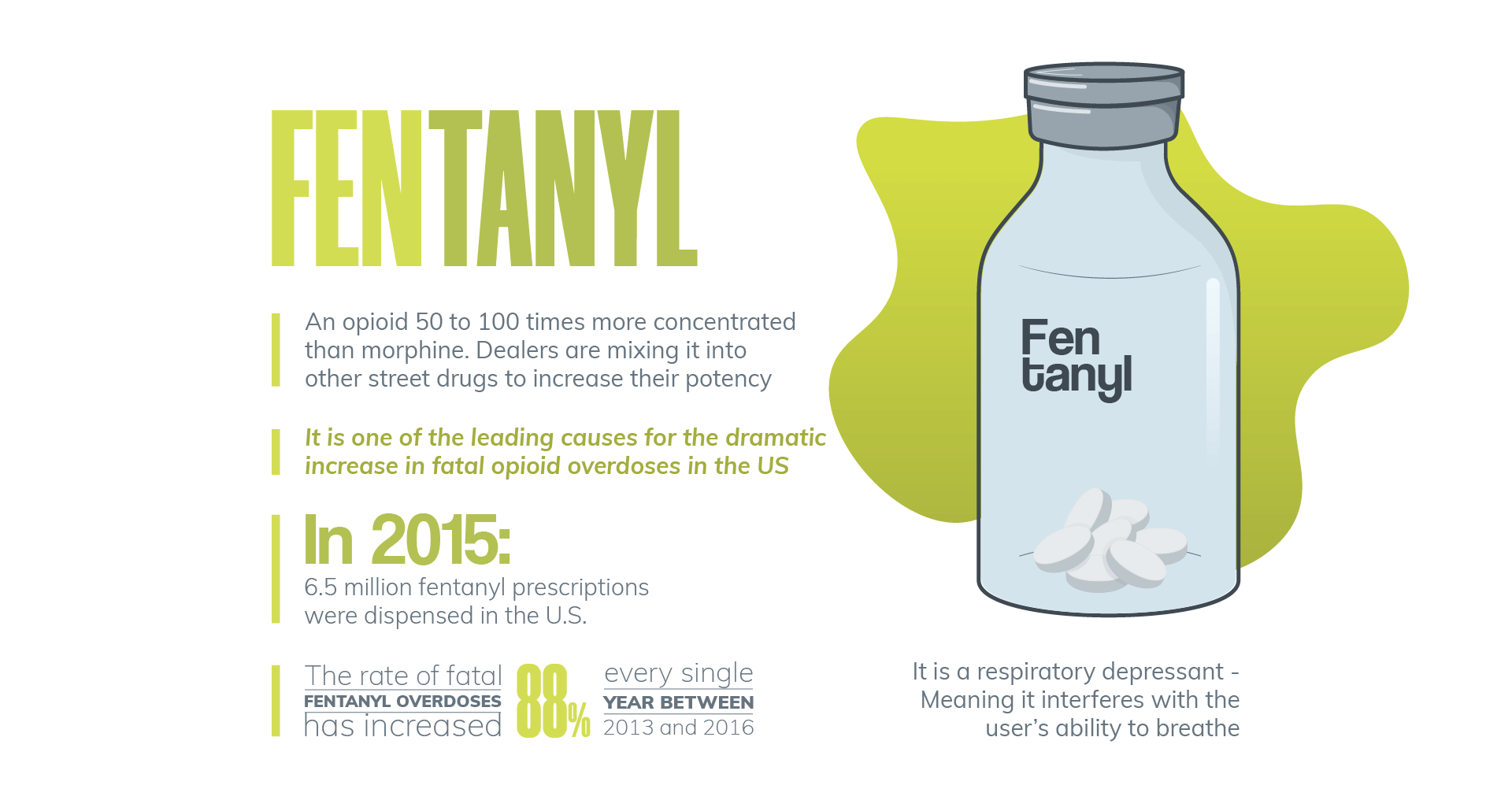
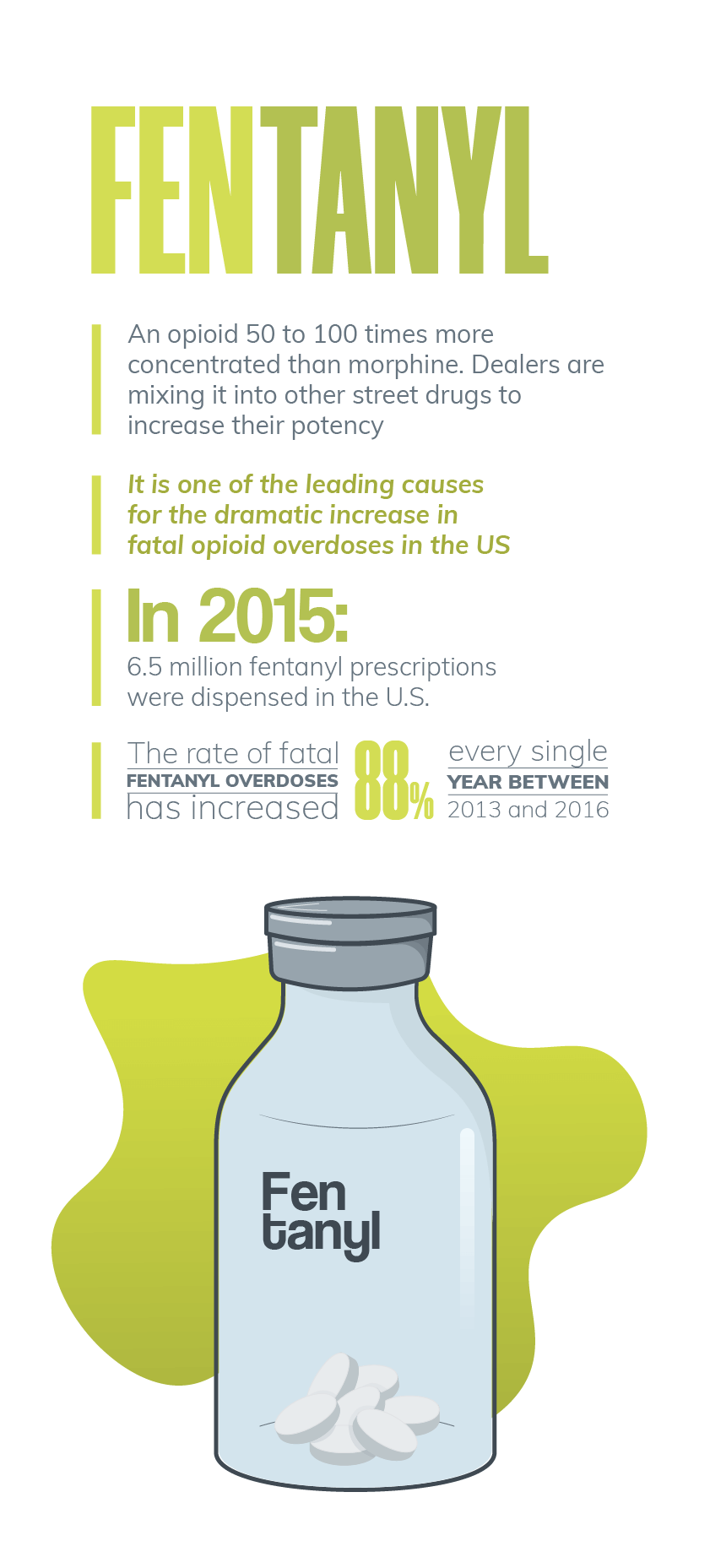
Unsurprisingly, when Fentanyl is abused, overdose is common and sometimes fatal. This is primarily because the euphoric effects of Fentanyl are short-lived and the user's tolerance to the drug builds quickly. This leads abusers to keep increasing the dose to try to achieve the same effect, which often proves fatal.
Here are some statistics that show the devastating effect that Fentanyl has had as part of the opioid epidemic in the United States:
While many opioid-related deaths involve heroin and prescription opioids like hydrocodone, oxycodone, and OxyContin, addiction experts seem to be most concerned about Fentanyl. This is largely due to to the amount of illegally manufactured Fentanyl that is available on U.S. streets.
Illegally manufactured Fentanyl will be sold as Fentanyl, but it is often put into other illegal drugs - such as heroin, cocaine, oxycodone, crack or meth - in order to increase their perceived potency.
It can also contain dangerous contaminants or even have varying levels of Fentanyl in each tablet. These levels can vary from very little Fentanyl to lethal levels.
The effects of Fentanyl abuse and addiction can include:
Prescribed predominantly for anxiety, stress, panic attacks, and nervous disorders, Valium, or diazepam, was the highest-selling prescription drug in the U.S. between 1968 and 1982. Another drug classed as a benzo, like Xanax, Valium basically has a sedative effect, and, like other benzos, is referred to as a "chill pill."
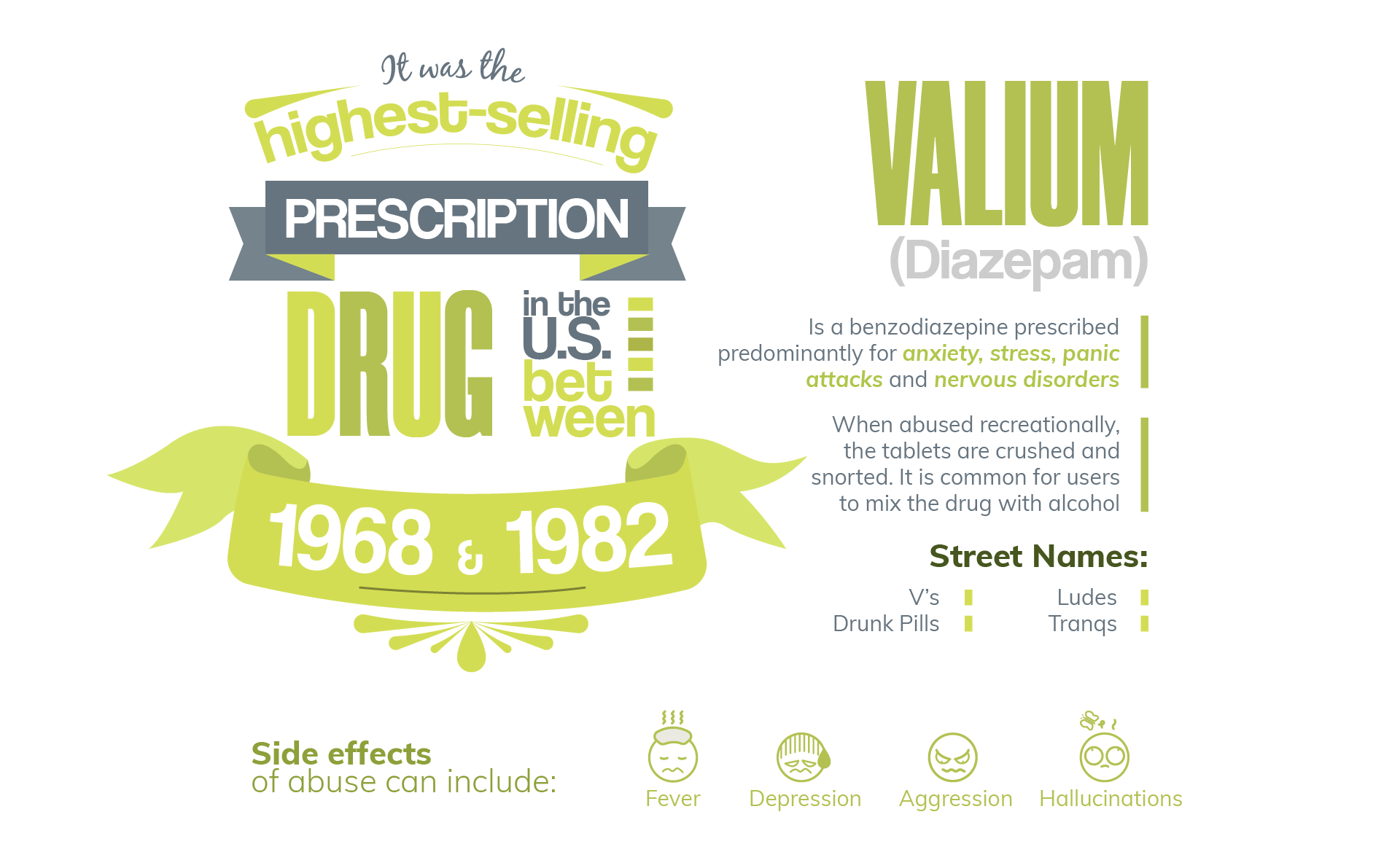
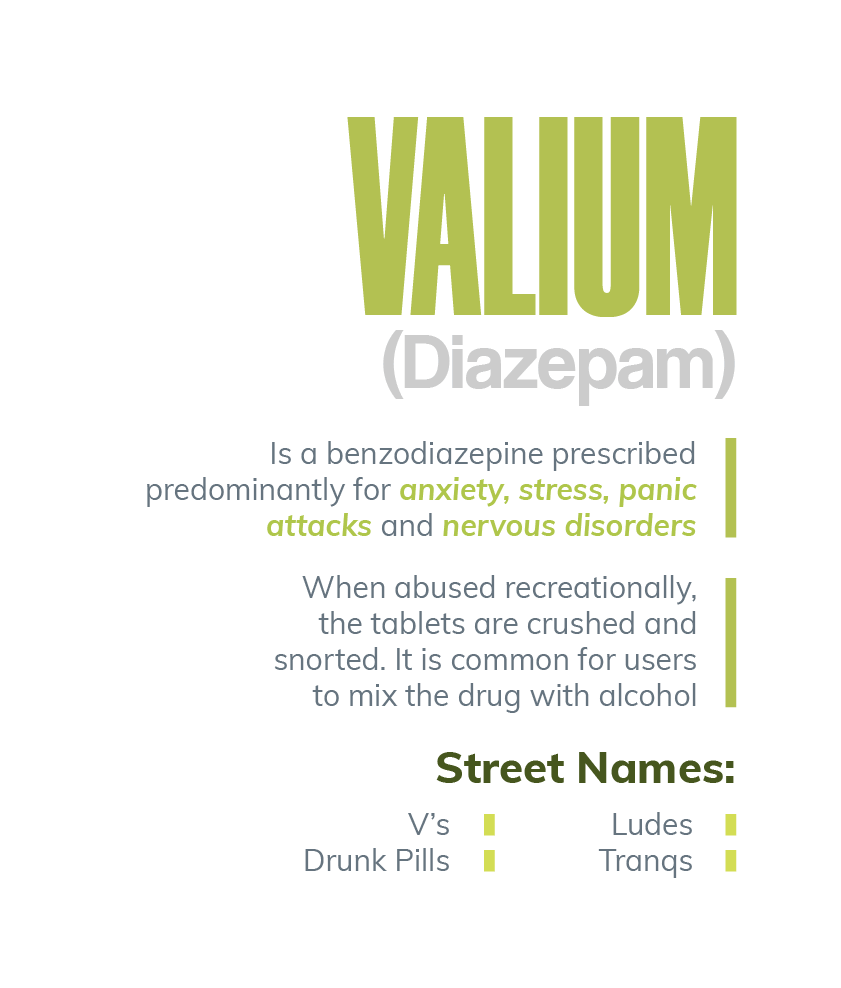
However, its recreational use has been apparent for decades, and, as more and more youngsters are searching to find the hidden gems in their parents' and grandparents' medicine cabinets, it is still high on the list of the most abused prescription drugs. When abused recreationally, the tablets are crushed and snorted, and it is common for users to mix the drug with alcohol.
Slang names for Valium include:
Snorting crushed Valium will cause the potential destruction of the sinus and nasal cavities, as previously highlighted with other benzos, and, like other benzos, the side effects of abuse can include:
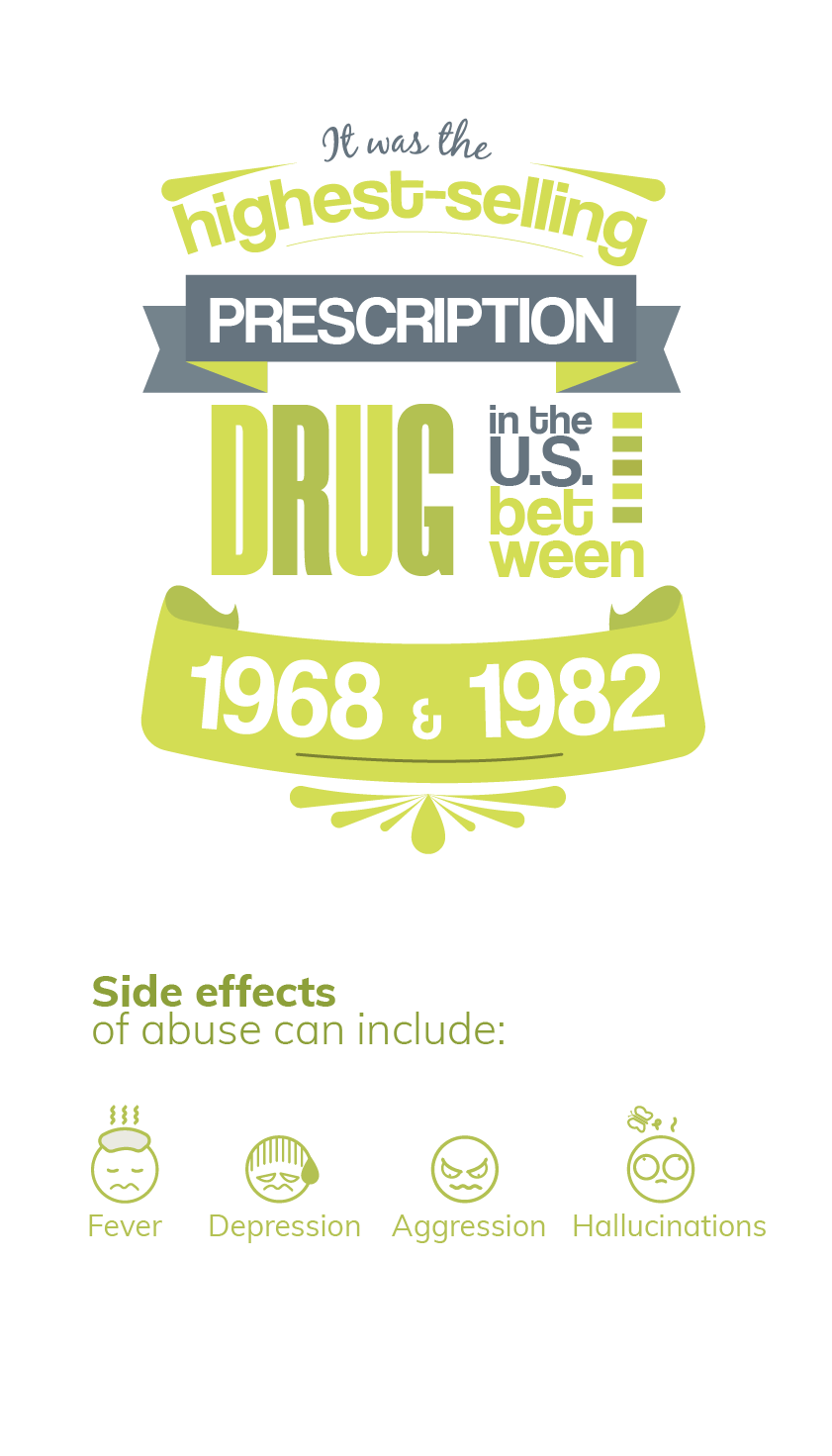
When Valium is mixed with alcohol (or other drugs, for that matter), the danger of overdose increases dramatically. The signs of a Valium overdose include:
Because of the high prescription rates and illicit availability of diazepam, a noticeable increase in use and abuse has been found in young people, particularly teenagers. The National Institute on Drug Abuse (NIDA) issues an annual survey as part of its "Monitoring the Future" study, and benzo use is collectively referenced as tranquilizers. Of worrying concern is that the 2015 NIDA survey found that:
Ambien (or zolpidem) is primarily used to treat short-term insomnia in adults and belongs to a class of drugs known as sedative-hypnotics because it produces a calming effect upon the brain. Although it has the same medical effectiveness as benzodiazepines (like Xanax and Valium), it is referred to as a non-benzodiazepine "z-drug", supposedly without the same addictive properties that benzos have. A massive 40 million prescriptions for Ambien alone are given out each year to patients with insomnia.
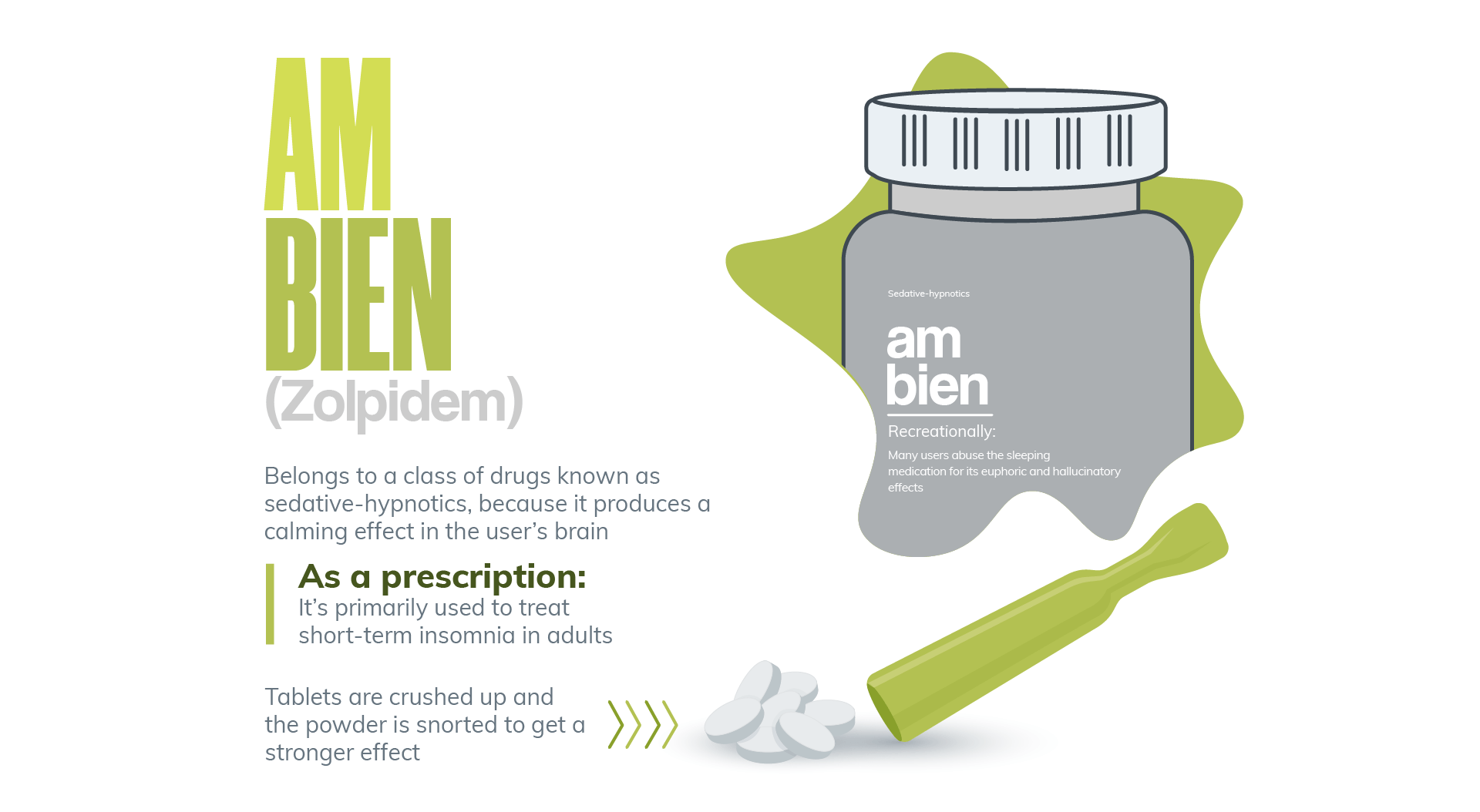
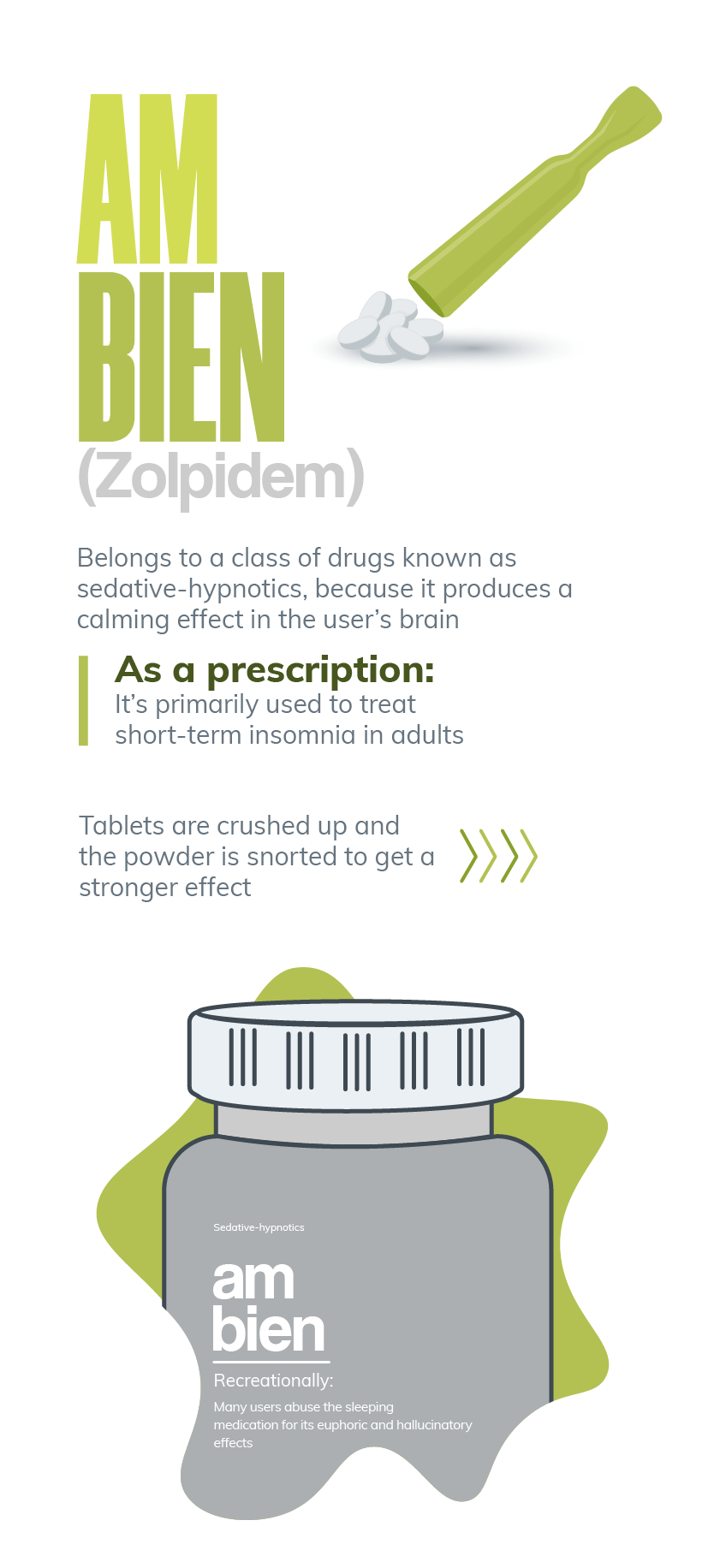
However, Ambien is still an addictive substance if abused, and an addiction can take as little as two weeks to occur. Many people are unaware of this until they stop using the medication and begin to experience withdrawal symptoms.
Those who abuse Ambien often crush up their tablets and snort the powder to get a stronger effect. Slang terms for Ambien, available on the street, include:

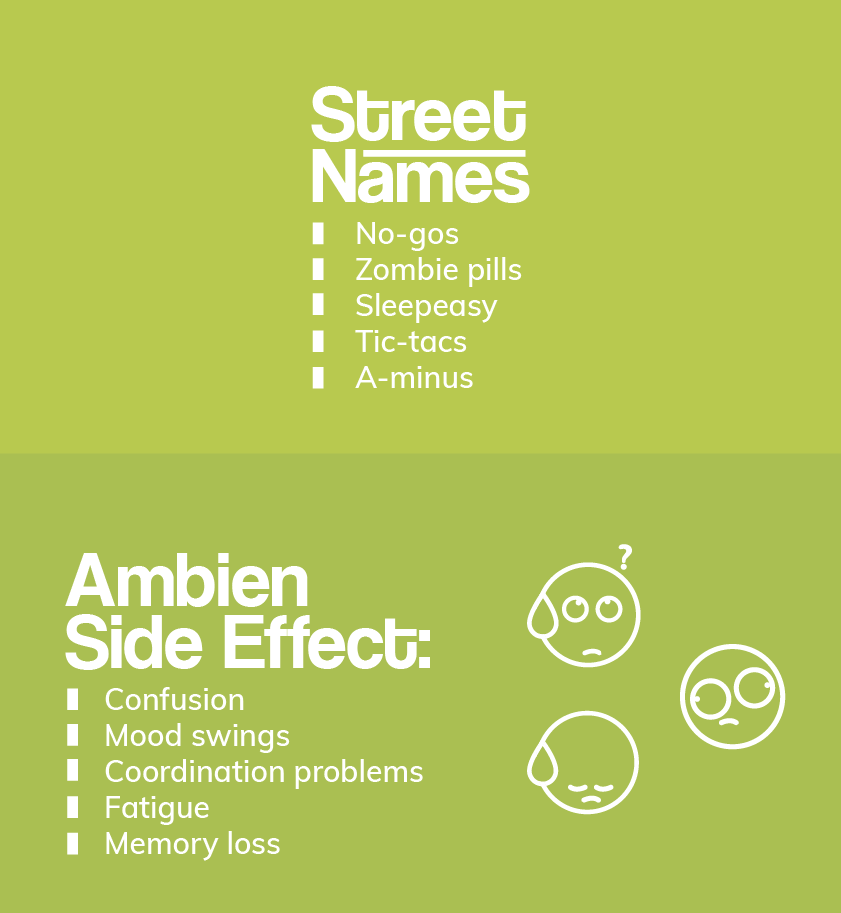
Ambien is a classed by the DEA as a schedule IV controlled substance, meaning people are unlikely to use it recreationally. However, many users abuse the sleeping medication for its euphoric and hallucinatory effects. In fact, the National Survey of Drug Use and Health reports that around half a million U.S. citizens currently abuse Ambien and similar sedatives.
Ambien abuse has similar side effects to benzos, such as:
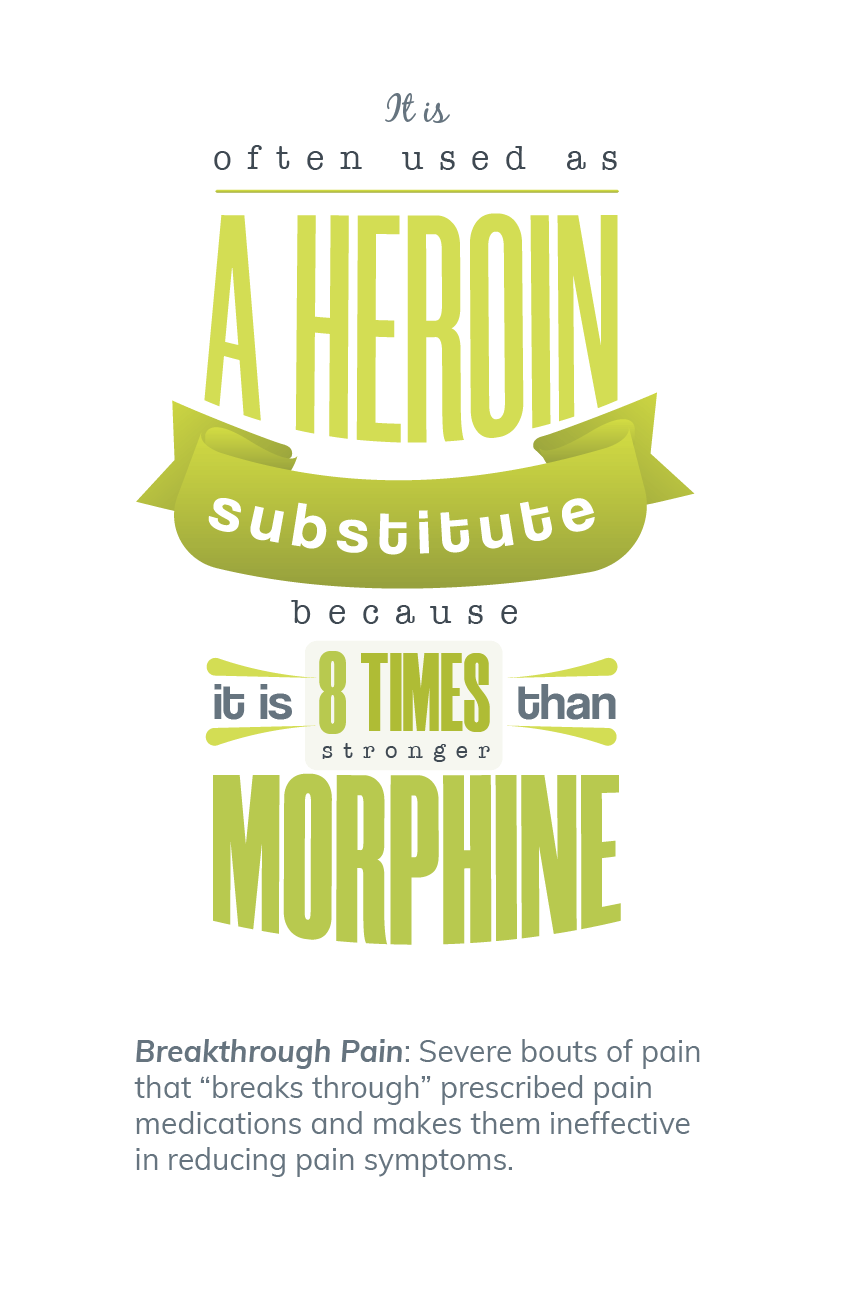
Ambien overdose is possible, and the signs of this are:
If Ambien is mixed with alcohol or other sedatives, the risk of fatal overdose increases greatly.
Possibly not as well-known as those prescription drugs listed above, Soma (or carisoprodol) is a short-term muscle relaxant, usually taken as part of a course of treatment for muscle pain and spasms. The reason it's intended as a short-term medication (for no more than 3 weeks, unless otherwise directed by the physician) is that it is highly addictive.
Soma is abused for recreational purposes, and the 2012 National Survey on Drug Use & Health reported that over 3 million U.S.citizens had done so. It is often mixed with other drugs or alcohol (or both) to intensify their effects. In fact, 2 popular soma narcotic cocktails include:
When used as prescribed, its side effects are mild, and can include:
However, when abused, the effects can be significantly more severe, such as:
When high doses of Soma are taken with alcohol to achieve a sedative effect, there is a significant risk of a state of complete confusion, coma, and even death.
Prescribed for moderate to severe pain, Dilaudid (or hydromorphone) is predominantly administered intravenously within a hospital setting after surgery. It has proven to be successful at easing pain when other opioid pain relievers cannot help.
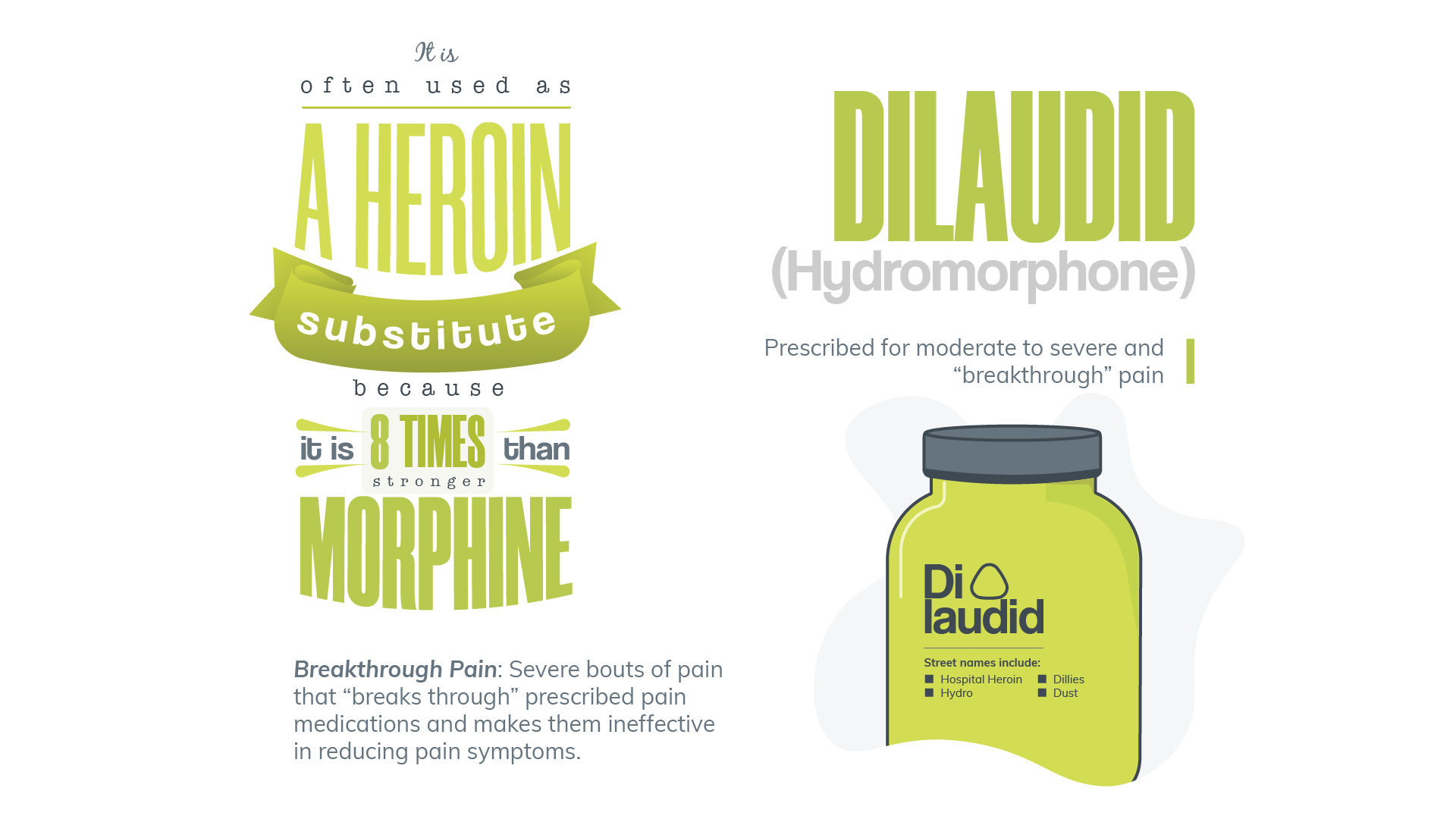
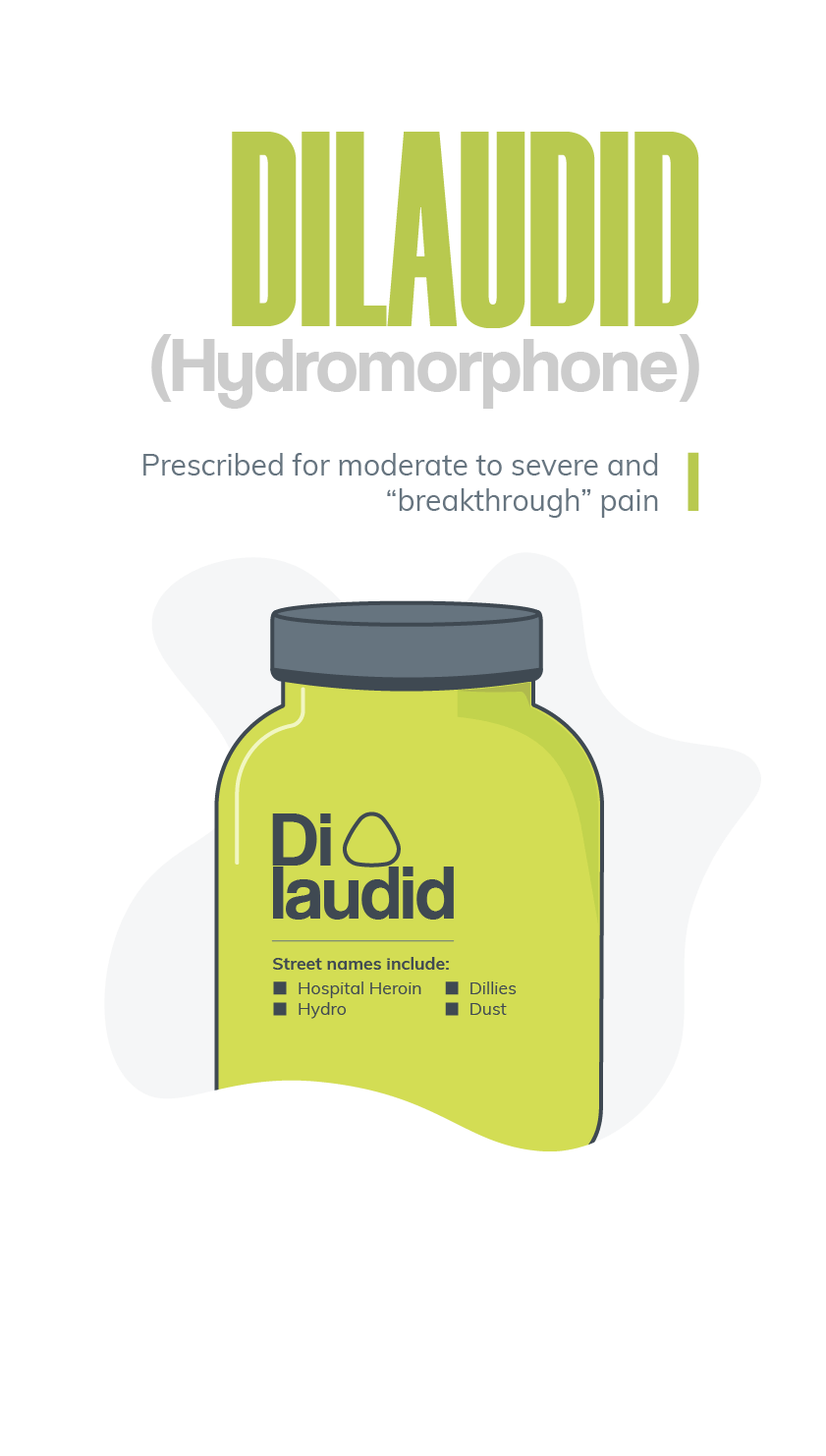
However, Dilaudid is a dangerous and highly addictive drug when abused, and it is often used as a heroin substitute by users because it is eight times stronger than morphine. In fact, many abusers of the drug will mix it with heroin or cocaine, making a highly lethal polysubstance combination.
Street names for the drug reflect the fact that it is usually administered intravenously in a hospital setting:
However, Dilaudid does also come in tablet form, and it is being increasingly prescribed by doctors to patients who are unable to get the pain relief they need from other opioids. Used as directed, there should be only a very marginal chance of addiction issues. However, those wishing to abuse it for recreational purposes can and do simply crush the tablets and snort the resulting powder.
In liquid form, it is either directly injected (as with heroin) or it can be "plugged." Plugging Dilaudid involves inserting the medication anally. This is said to to increase the drug's bioavailability, meaning that more of it is readily absorbed into the body.
Abuse of Dilaudid can result in:
Withdrawal from Dilaudid addiction can result in normal symptoms associated with opioid-based prescription drugs, but with the addition of an alarming tendency toward suicidal thoughts.
Percocet is an opioid-based prescription combination of oxycodone and acetaminophen classed as a schedule II controlled substance. It is normally prescribed for the short-term relief of moderate to severe pain, i.e. post-surgical pain or pain from injury. However, as we have seen, this also makes it a prime candidate for abuse and addiction.
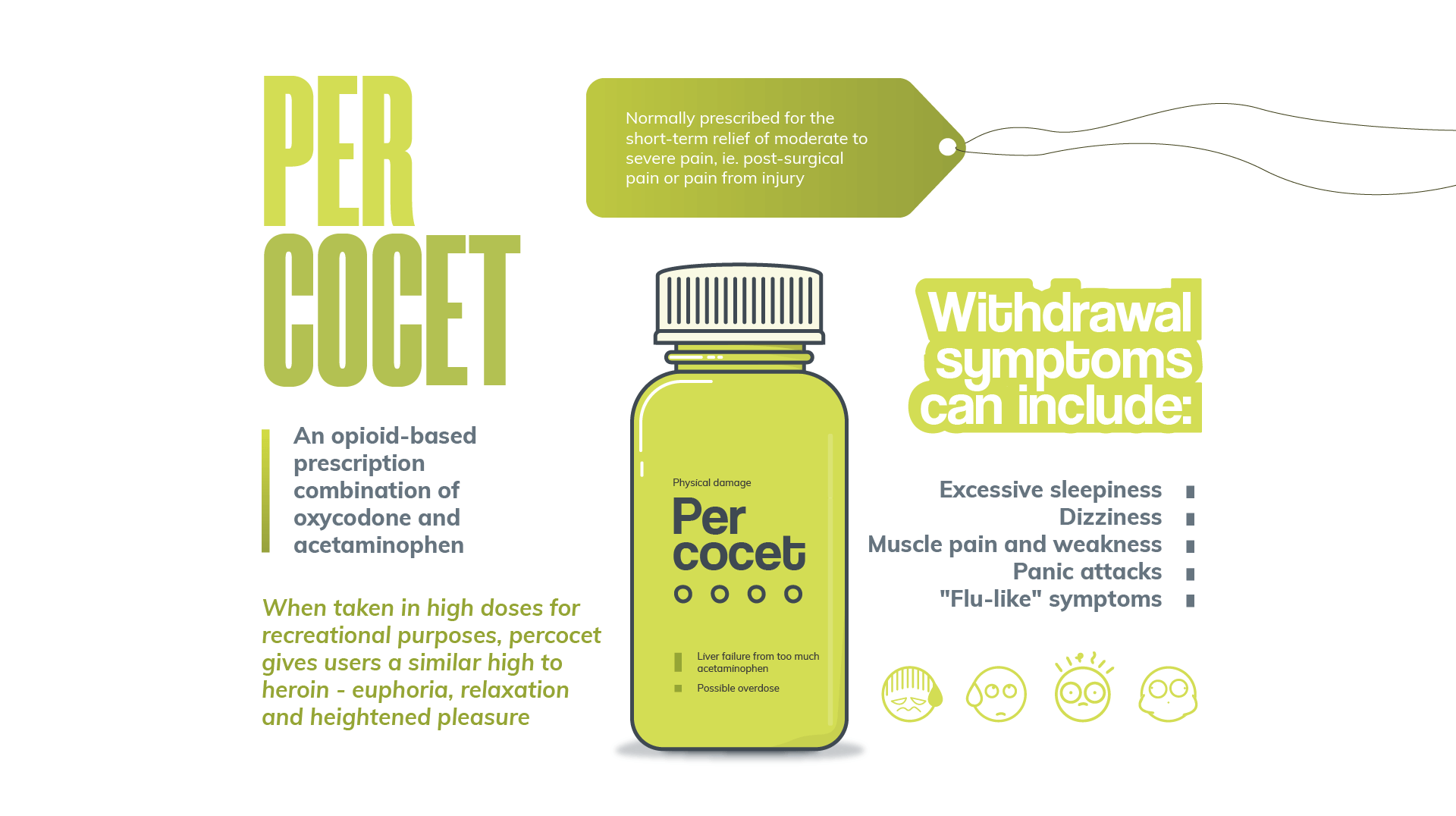
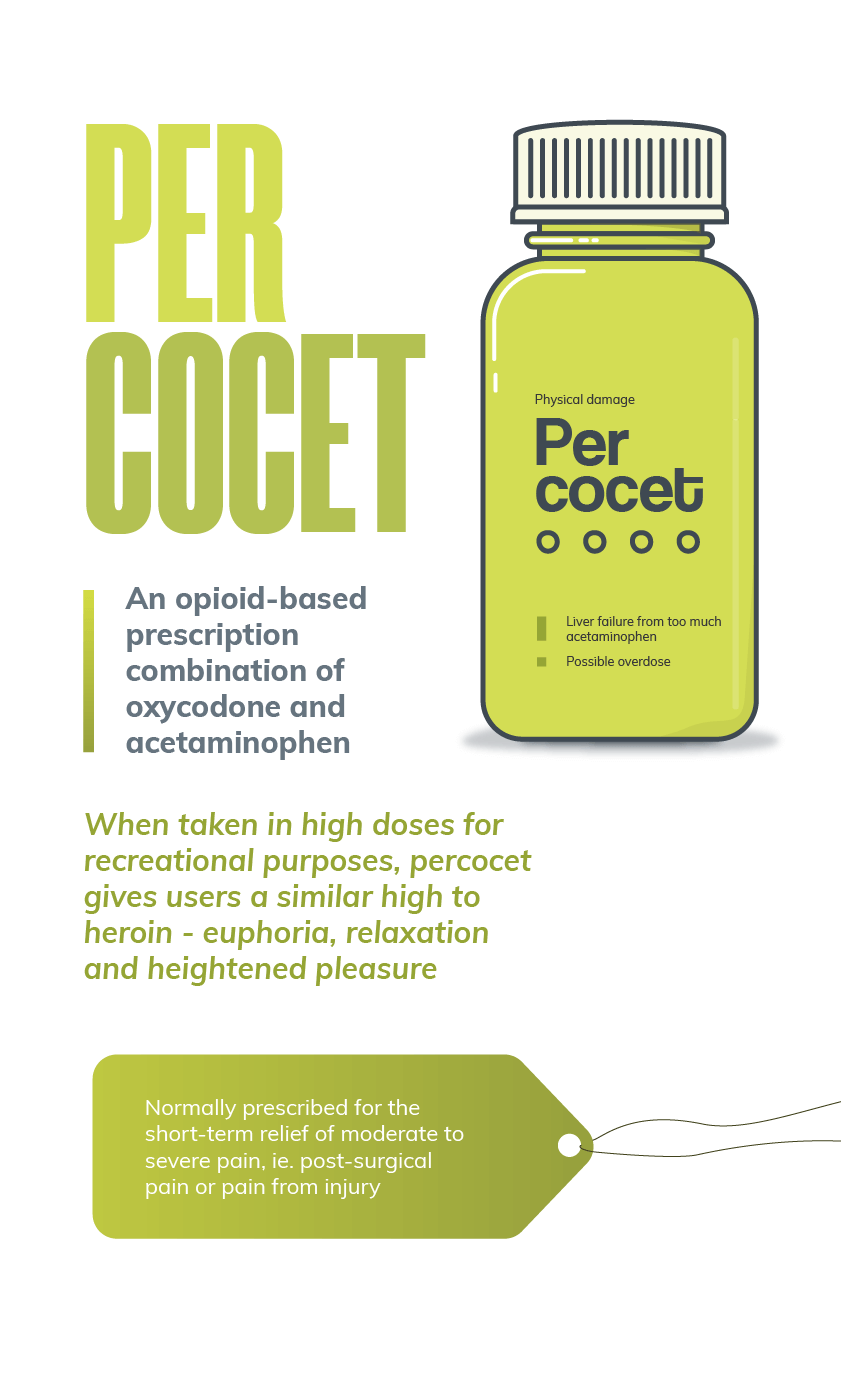
In fact, when taken in high doses for recreational purposes, Percocet gives users a similar high to heroin - euphoria, relaxation, and heightened pleasure. Should the Percocet be no longer available, users often resort to buying heroin off the street since it is markedly cheaper and easier to access. Additionally, those abusing percocet either chew their tablets, crush and snort them, or inject the diluted powder.
Percocet abuse very often leads to physical dependence and addiction. Compulsive misuse of Percocet can cause:
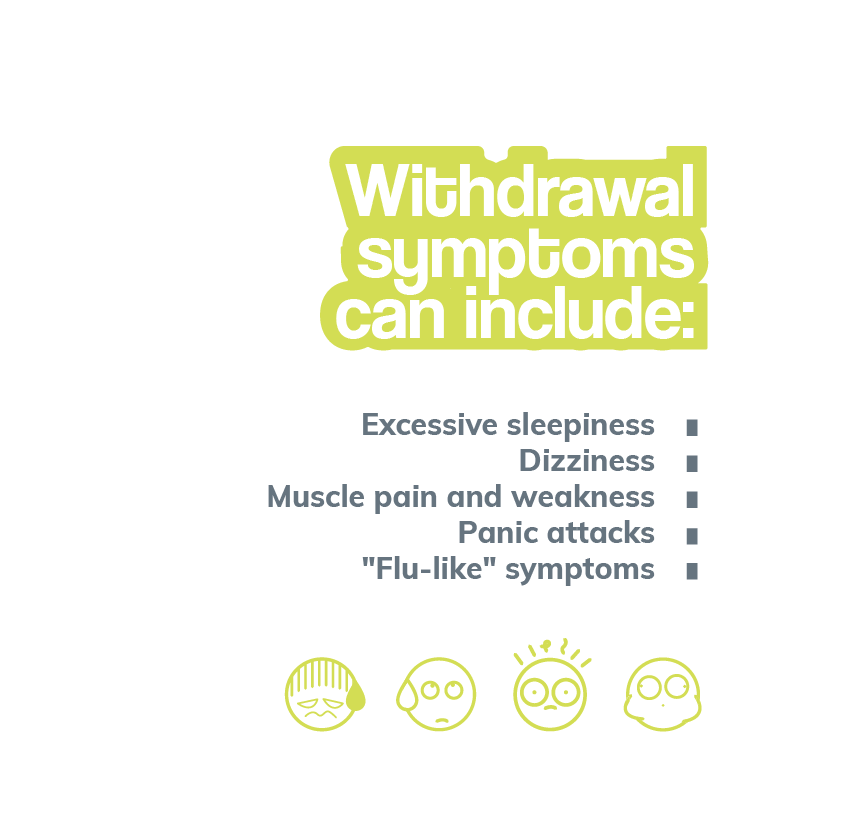
Withdrawal symptoms can include:
Possibly not as well known as Adderall and Xanax, Celebrex (or celecoxib) is an anti-inflammatory and psychotropic medication. It is normally prescribed for the treatment of pain, such as arthritis and inflammation. However, because it is a psychotropic drug, it can also be used in the treatment of certain mental disorders, such as PTSD, anxiety, depression, and even schizophrenia.
A psychotropic drug is any drug capable of affecting the mind, emotions, and behavior of the person using it. Lithium, for example, which is a legal medication used to treat bipolar disorder, is a psychotropic drug, and so is the illegal drug cocaine.
Celebrex was nearly taken completely off the pharmaceutical market back in 2005 because the manufacturers had failed to warn patients of the significant increased risk of heart attacks and strokes when taking the prescription. When mixed with alcohol, there is a strong chance of both stomach and intestinal bleeding.
Abusers of Celebrex can overdose on the drug, and the overdose may display a number of the following symptoms:
The opioid epidemic in the U.S. has resulted in thousands of people seeking treatment for their prescription drug addictions. Unsurprisingly, the pharmaceutical companies have been keen to market new drugs that can assist in both the withdrawal process and long-term recovery. One such drug is Suboxone, a combination of buprenorphine and naloxone.
Suboxone is designed to be used in Opioid Replacement Therapy (ORT). The aim of ORT is to provide an alternative opioid-based substance to the one that has been abused, in order to:
However, by replacing the abused opioid with an alternative, prescribed opioid, albeit of a lesser strength, the potential for prescription drug abuse still exists. The intention with ORT is to slowly wean the addict away from opioid medications altogether, since it is only used for a rigid, specified length of time.
The opioid ingredient of Suboxone is buprenorphine and is referred to as a partial opioid agonist, meaning it blocks specific receptors in the brain, reducing cravings. The presence of naloxone is there to help reverse the effects of the opioid. The two combined are still an addictive substance, as they have the following effects on the user:
Possible side effects of Suboxone use include:
Suboxone abuse can present a host of risks, including:
Signs of a suboxone overdose are extremely serious and can include:
Sertraline, whose brand name is Zoloft, is prescribed for the treatment of a number of psychological conditions; namely depression, panic attacks, obsessive compulsive disorder (OCD), PTSD, social anxiety disorder, and a severe form of premenstrual syndrome known as premenstrual dysphoric disorder.
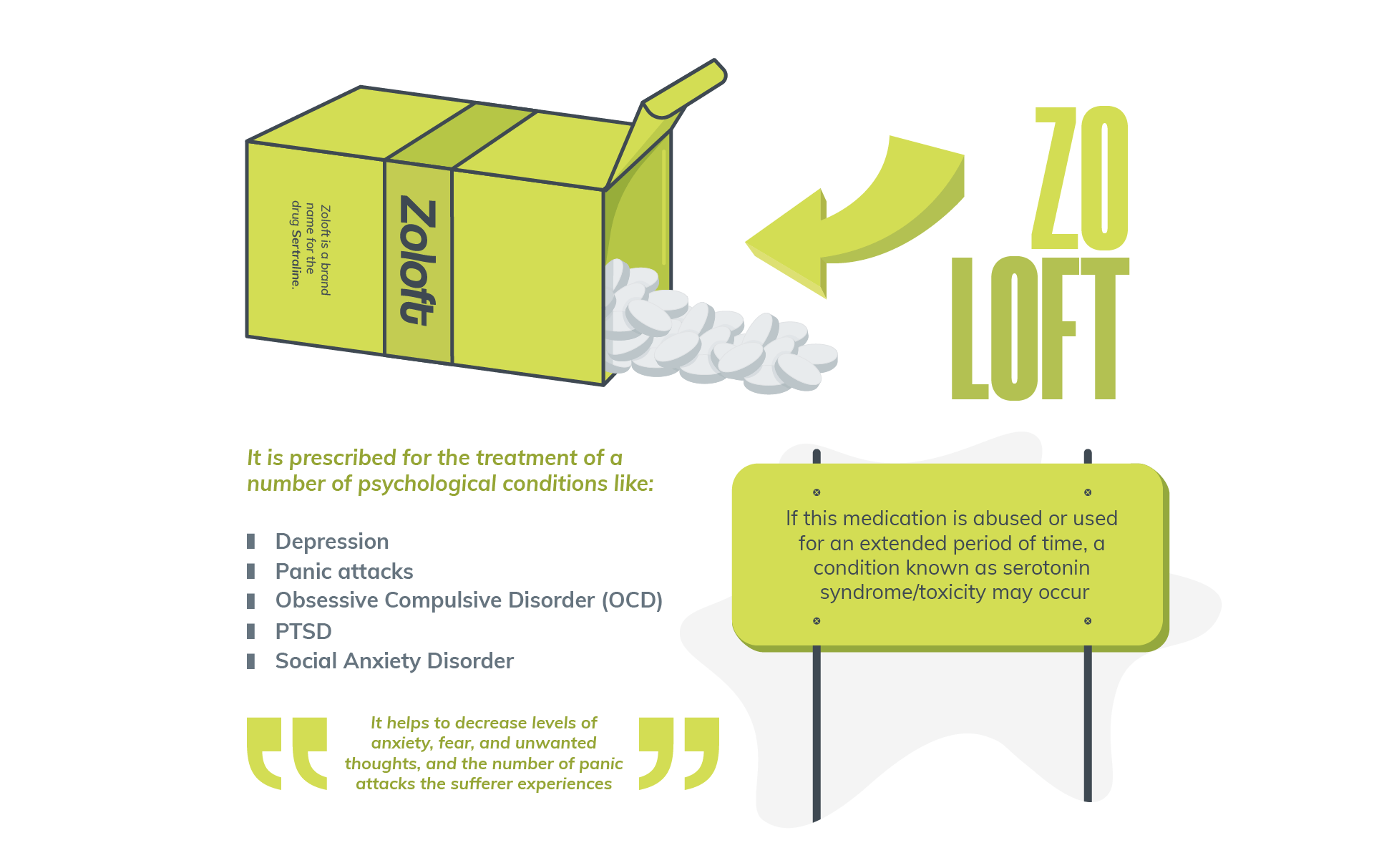
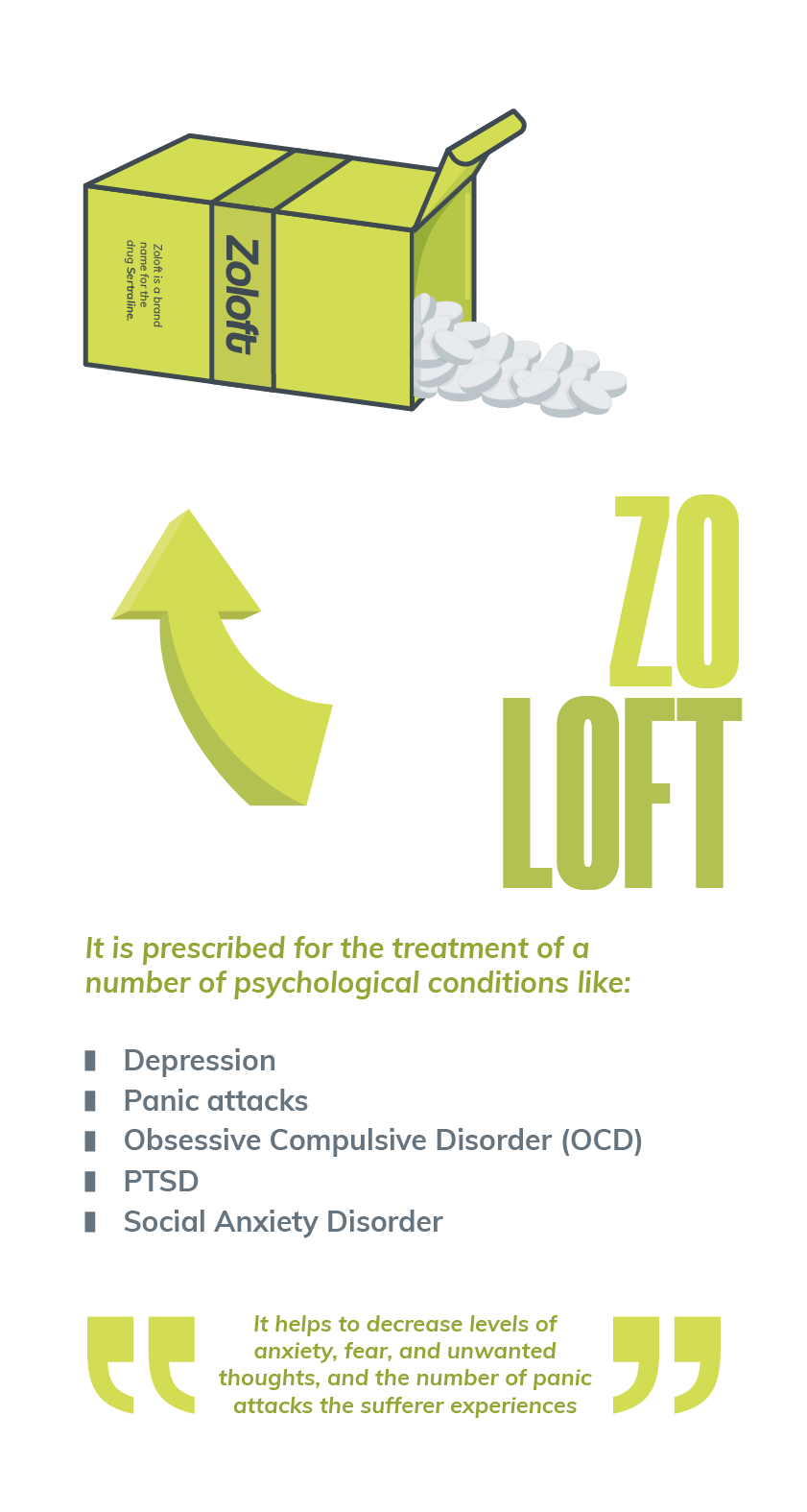
Its aims are to make noticeable improvements in general mood, sleep patterns, appetite restoration, and energy levels in order to make a positive impact upon a sufferer's quality of life and outlook.
It helps to decrease levels of anxiety, fear, and unwanted thoughts, as well as the number of panic attacks the sufferer may be experiencing on a regular basis. With regard to OCD, it helps to curb the desire to perform repeated tasks, known as compulsions, e.g. hand-washing and checking, that can seriously interfere with a person's quality of life.
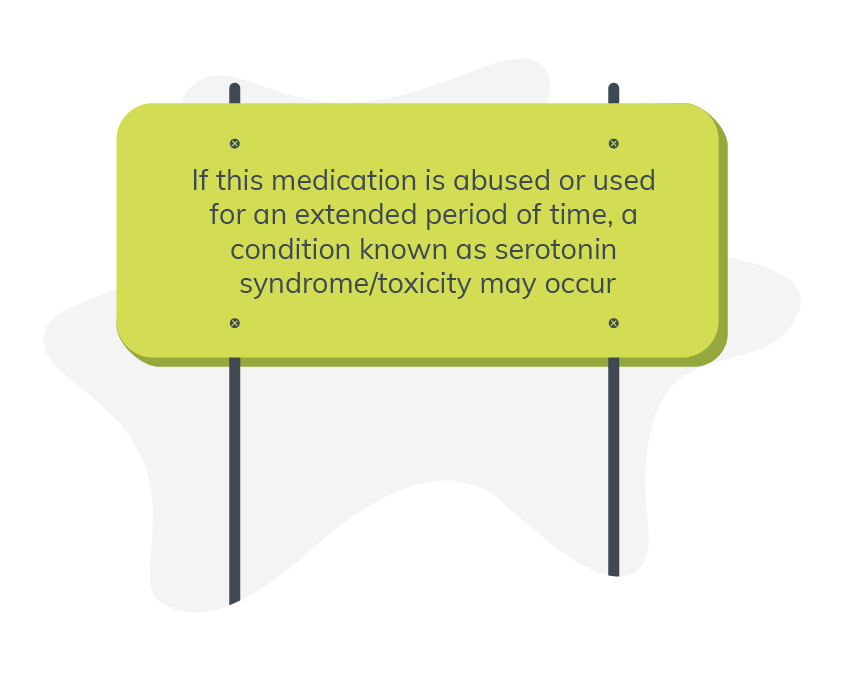
Sertraline is a selective serotonin reuptake inhibitor or SSRI, and it works by helping with the natural balance of serotonin in the brain. Serotonin is a chemical produced in the brain that affects a whole host of natural bodily functions.
If this medication is abused or used for an extended period of time, a condition known as serotonin syndrome/toxicity may occur. The risk increases if you are also taking other drugs concurrently.

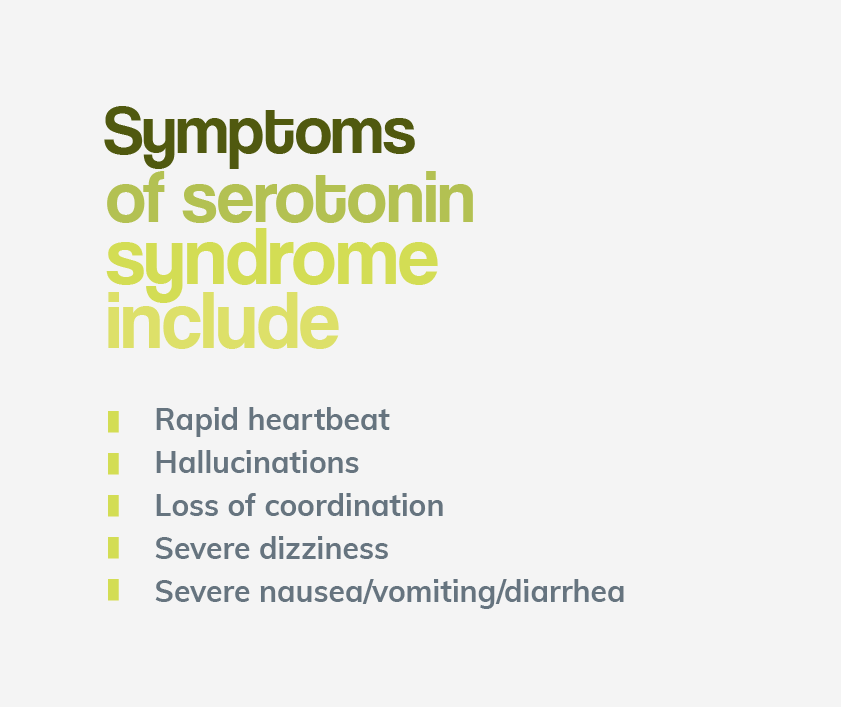
Symptoms of serotonin syndrome include:
Klonopin, or clonazepam, is another benzodiazepine, classed as an anti-epileptic drug, and is prescribed predominantly for helping with anxiety, seizures, and panic attacks. Like all benzos, it has a high potential for abuse and has a number of serious side effects, such as memory loss, drowsiness, and confusion.
Klonopin is one of the most dangerous and widely abused prescription medications in the U.S., and the most current data reports that almost 24 million prescriptions were written for this benzo in 2015.
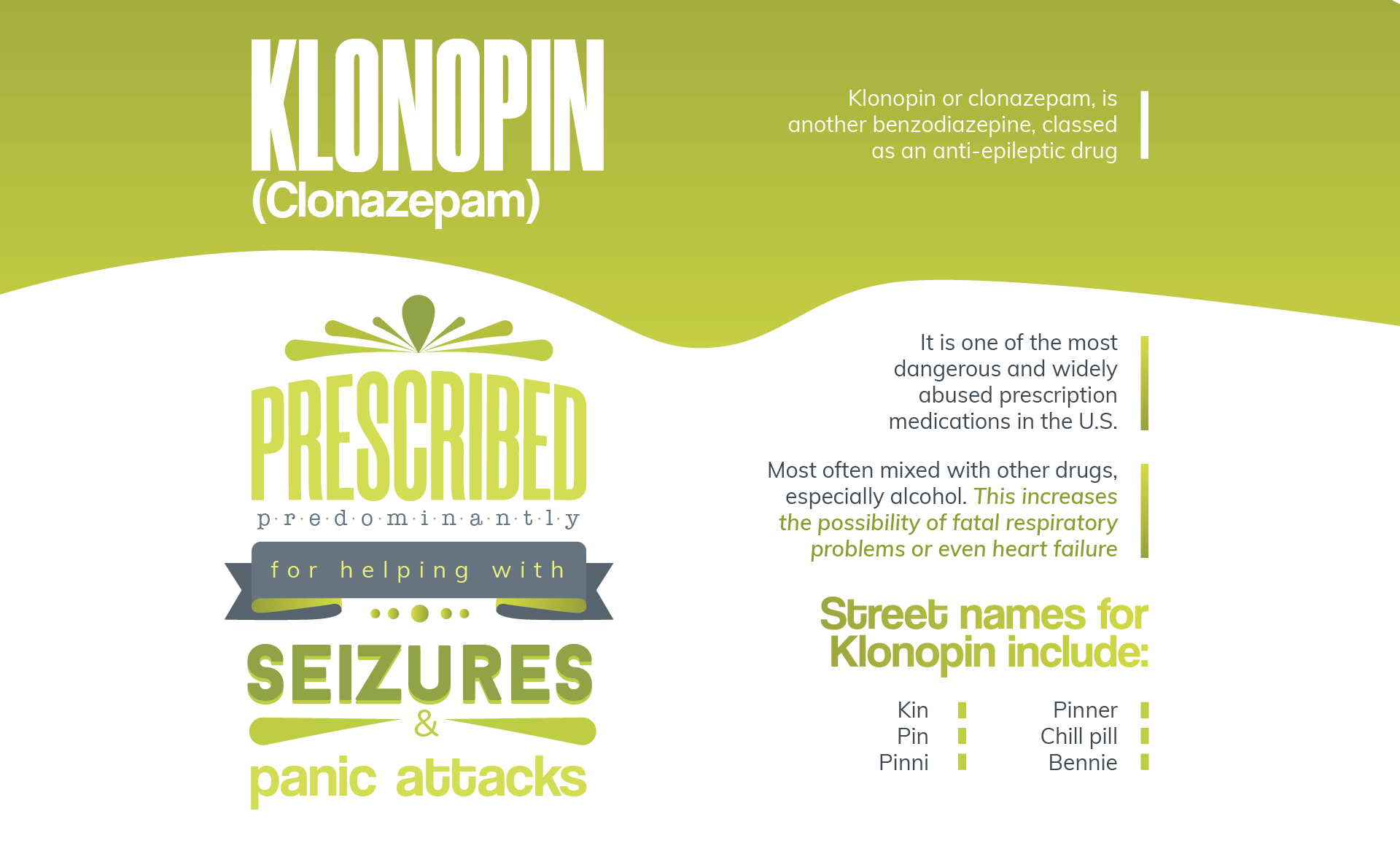
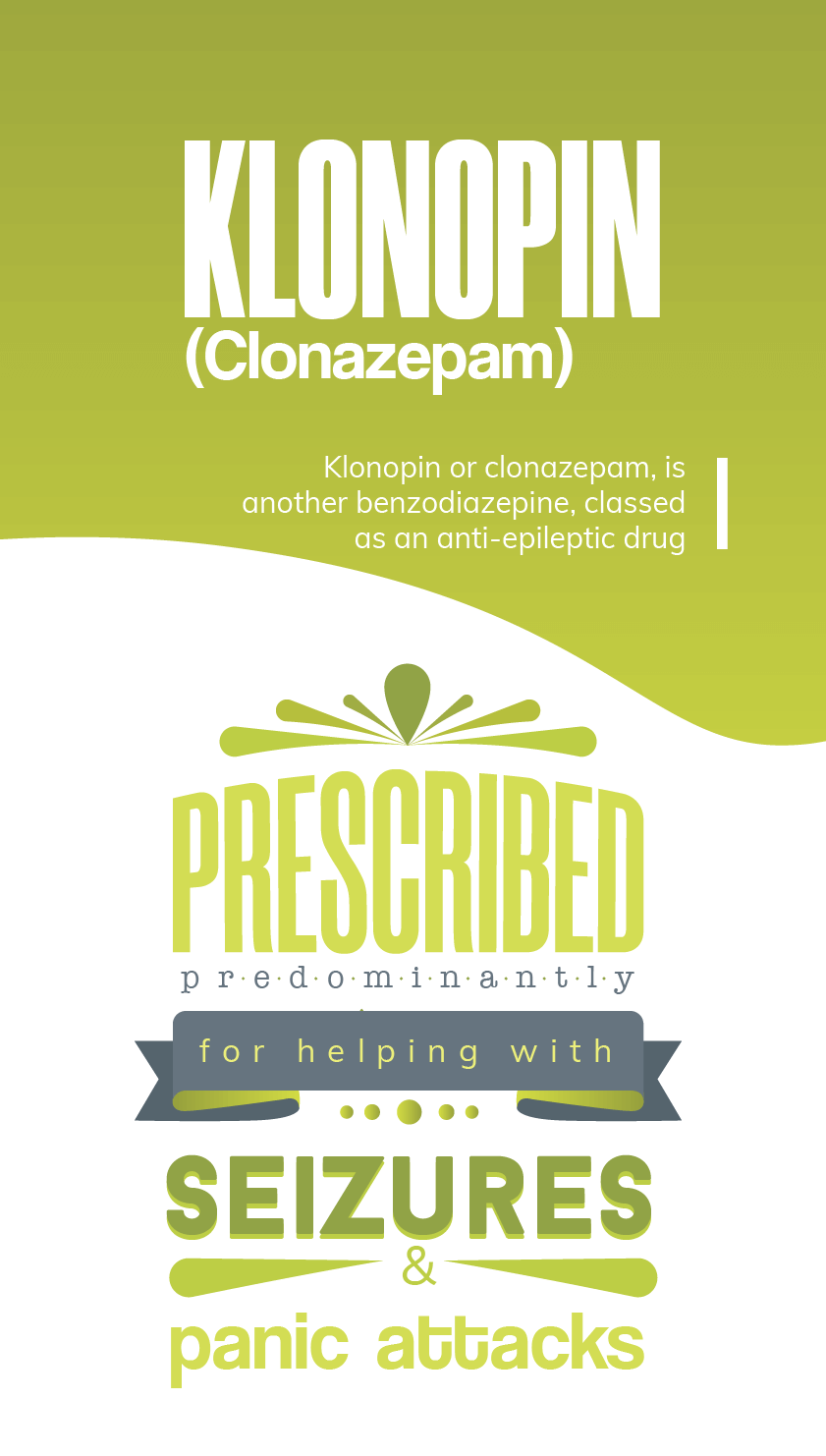
As with most other benzodiazepines, the high that abusers of the drug get from Klonopin results from the slowing of their internal functions, such as breathing, coordination, mental processes, and perception. It is not as strong as most other benzos, only providing a calming, sedative effect.
Because of this, Klonopin is more often mixed with other drugs, like alcohol. Since both are central nervous system depressants, there is an increased possibility of fatal respiratory problems or even heart failure.
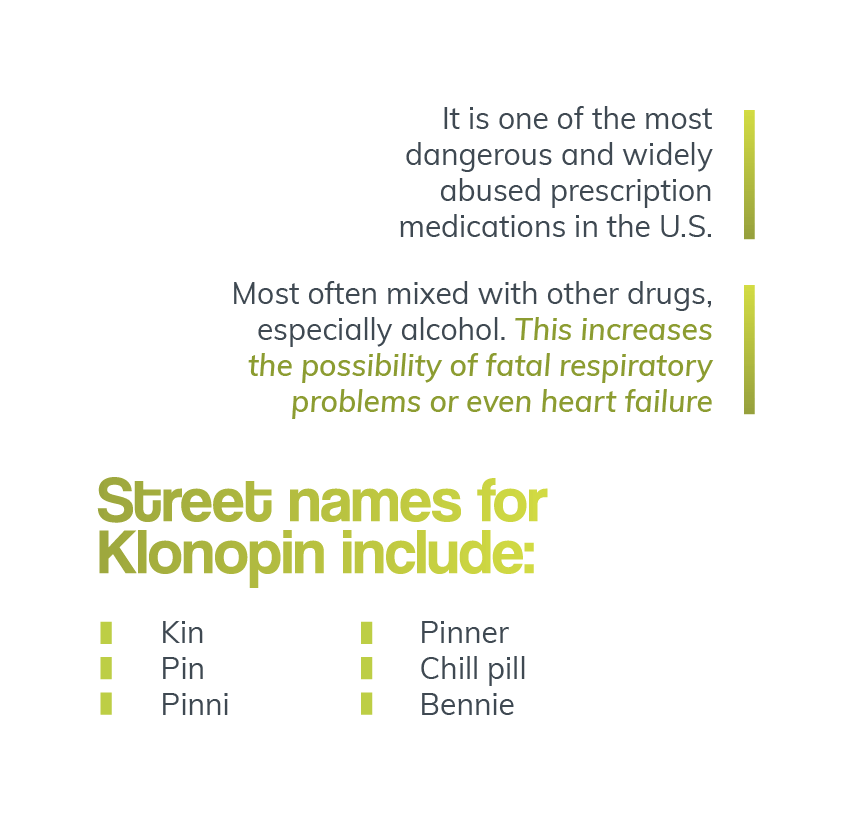
Street names for Klonopin include:
There are numerous signs of Klonopin abuse, including:
A Klonopin overdose can involve:
Let us reiterate one very important fact from all the information that has been provided above:
⅓ of all prescription drug abusers are aged between 12 to 17 years old. It's a frightening statistic with no easy answers. In fact, studies also reveal that as many as 1 in 5 teens have taken a prescription medication without having an actual prescription for it. Those studies also reveal that prescription drug abuse among teens affects every demographic of that generation, be it by race, geography, or socioeconomics.

However, the question remains:
What can we do to protect the younger generations from the dangers of prescription drug abuse?
We know that many teenagers want to get high occasionally or to get out and party, but many are others are simply trying to regulate and manage their lives. The abuse of prescription stimulants like Adderall demonstrates that teens feel a specific need for extra energy and concentration when in class or studying.
It goes even further. Many teenagers are abusing opioid painkillers and anti-anxiety tranquilizers in an effort to cope with the stress that academics, social interactions, or their family environments places them under. Lastly, prescription steroids are being abused so teens can bulk up, and amphetamines are being abused in order for them to lose weight.
One approach may be twofold; lying in the simple practicalities of a teenager's access to these medications and the necessary education required to explain the dangers of prescription abuse.
Firstly, the practicalities of access. We would not actively expose children to illegal drugs, such as cocaine or heroin. If such potent substances had to be present in our houses, we would place them under lock and key, at the very least. However, many parents simply do not take the practical steps to ensure that the contents of their medicine cabinets or their bathrooms are accounted for or that medications are being used explicitly by the patient they were prescribed for and as directed.
Secondly, just as we educate children about the dangers of illicit drugs, we should also be educating them about the dangers of a codeine-based cough syrup, or a parent's pain medications.
However, in another study by the Partnership for Drug-Free Kids. it was found that 28% of parents have themselves taken a prescription drug without actually having a prescription for it. This behavior sets a dangerous example for children and teenagers.
Remember, it is the deadly combination of opioid-based drugs that places people's lives at risk; 98% of all fatal overdoses involve polydrug abuse - the use of more than one substance. Prescription drug abuse in the U.S. has become a monstrous epidemic because the medications, such as opioid-based painkillers, now available are far stronger than ever before, more widely available, and seemingly the first choice of the family practitioner.
So, to summarize:
What Can Parents & Loved Ones Do to Help Prevent Teenage Prescription Drug Abuse?
Medication Assisted Treatment, also known as MAT or pharmacotherapy, is an addiction treatment where the drug that was being abused is replaced with a prescription drug. A subtype of this is ORT (Opioid Replacement Therapy), which was previously mentioned when Suboxone abuse was discussed. However, the treatments are differentiated in the following way:
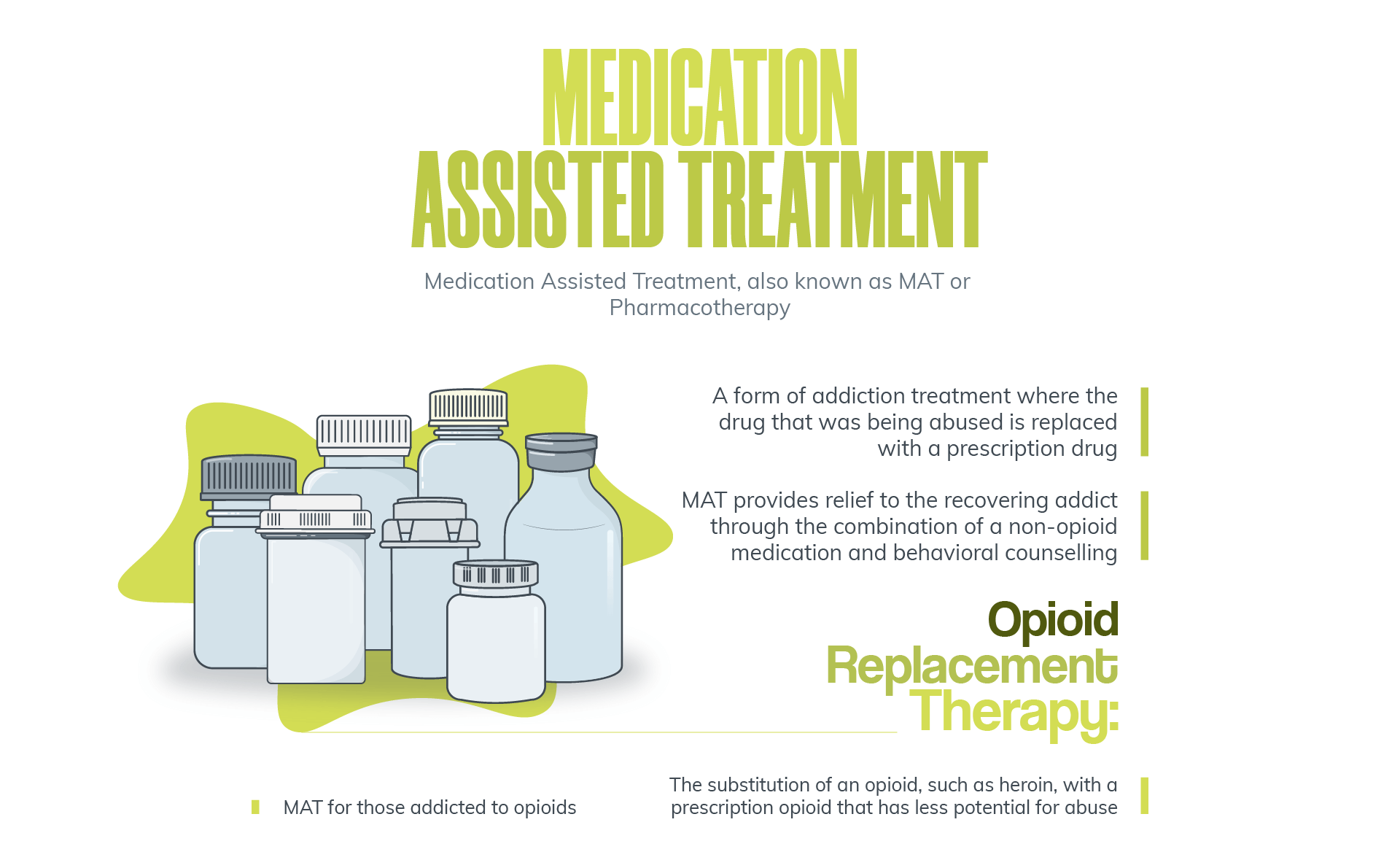
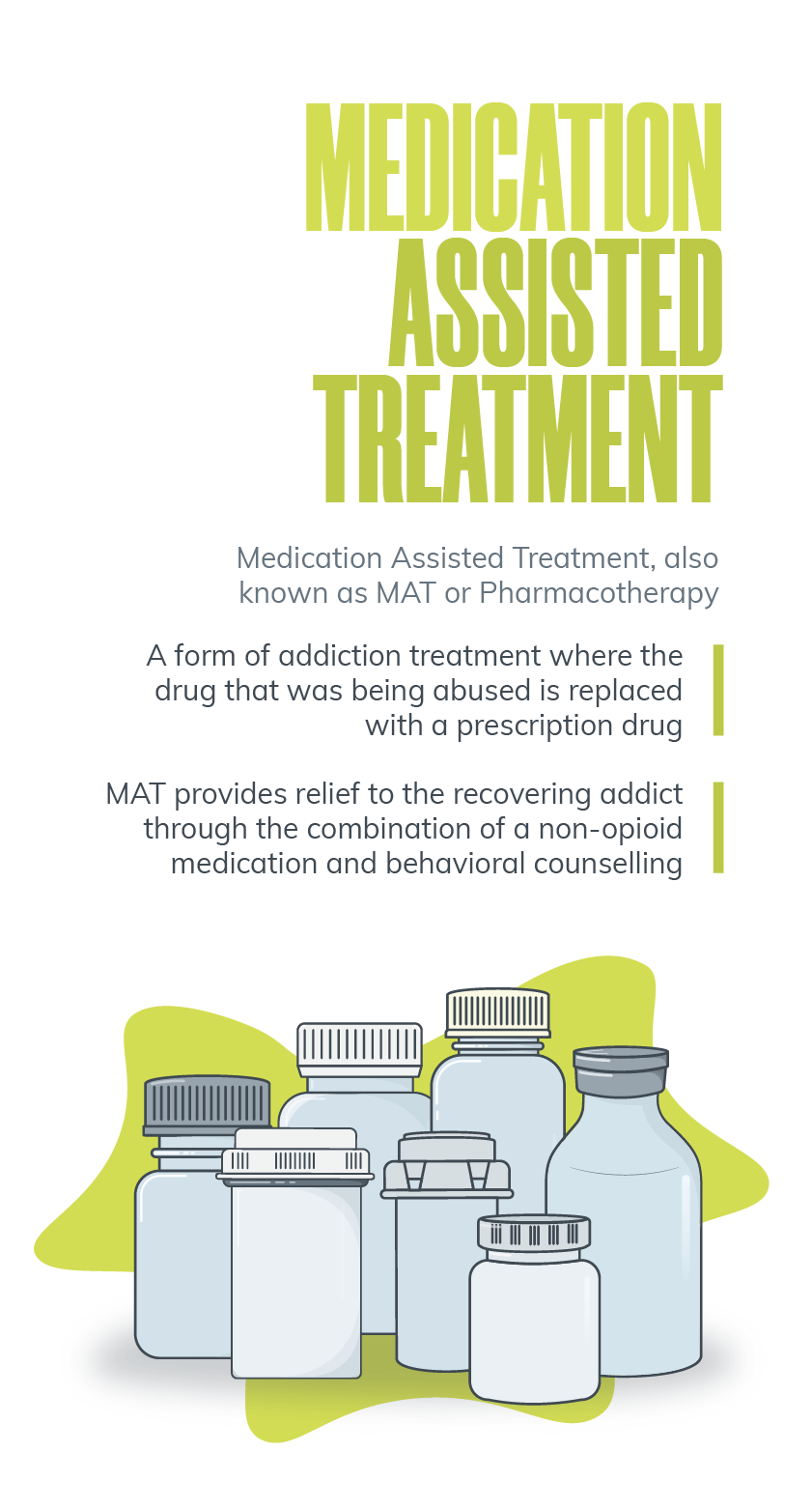
Naltrexone is a prescription drug currently being used very successfully in the treatment of both alcoholism and opioid addiction. It is what is known as a "full opioid antagonist drug," meaning its primary use is to block the euphoric effects of opiates like heroin and other opioid drugs, such as medically-prescribed opioids.
Opioid antagonists such as naltrexone act in the following way:
The opioid system controls pain, reward, and addictive behaviors. Opioid agonists, such as Fentanyl, heroin, and oxycodone, bind tightly to opioid receptors in the brain and then undergo significant changes to produce a maximal effect.
However, by introducing a full opioid antagonist, e.g. naltrexone, into the body's system, a protective blockade is produced around the receptors themselves. This results in the agonist failing to create their tight bind on the receptor, thus stopping any euphoria from occurring in the first place.
Naltrexone has been proven to successfully help to stabilize a recovering addict's life and to reduce the harm and effect of possible drug use. It is available either as a tablet to be taken daily or as an extended-release injection; this injection goes by the brand name Vivitrol, given every 30 days or as an implant.
It's important to understand that naltrexone doesn't treat withdrawal symptoms. Its prescribed use can only begin 7-10 days after a patient has undergone a medically-supervised detox, meaning that they are clear of any withdrawal symptoms first. However, once naltrexone is in the recovering addict's system, the chances of a relapse are greatly reduced.
As we said at the beginning of this guide, it is important to remember that even though addiction is an incurable, chronic disease, it is very possible to learn to manage the condition and to live a healthy lifestyle. Recovery, though difficult and challenging, is possible; there are millions of ex-addicts as proof. Yes, there is addiction, but there is always hope and help for those who suffer from it.

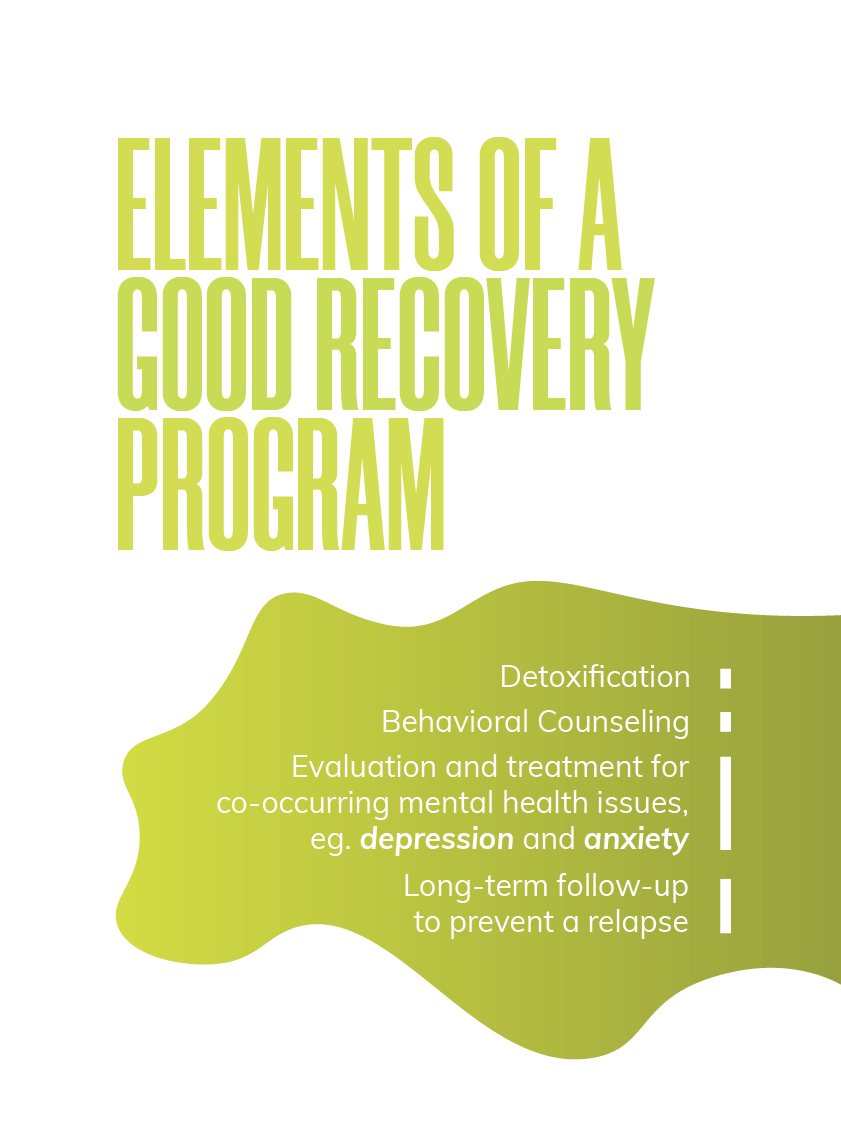
As an example:
One of the first steps on the road to recovery from prescription drug addiction is knowing exactly what treatment options are available. A successful recovery has the following five important elements, and only a recovery that has all of these gives the addict the best possible chance of a different, healthier future:
However, the first major decision for anyone seeking recovery will be to either enter into a professional drug rehabilitation treatment center (a rehab) or to attend a similar facility as an outpatient. When selecting a rehab, if that is the preferred option, a number of factors need to be considered:
More commonly known simply as detox, detoxification is the process of eliminating drug or alcohol use and removing the addictive substance from the body. It can be done as an inpatient or in an outpatient setting, although it does tend to be more effective when it's done in a professional rehab (a residential treatment center).
The actual specifics of any drug detox program are reliant upon the actual substance of abuse. However, in most cases, the detox itself takes only a few days to a week to complete. It's important to understand that the detox process for some prescription drugs may require the administration of other prescription medications to ensure the addict has the most comfortable passage through to its completion.
It's important to realize that detox alone will not cure an addiction, and the other steps described above still need to be followed. As with any health decision involving addiction and medication, always speak to a medical physician or addiction expert first.
In an Inpatient Program (IP) or inpatient rehab, addicts have 24-hour supervision from nurses or trained staff members, and they receive support when they need it the most. With inpatient rehab, residents get the proper nutrition necessary to help the mind and body recover as quickly as possible.
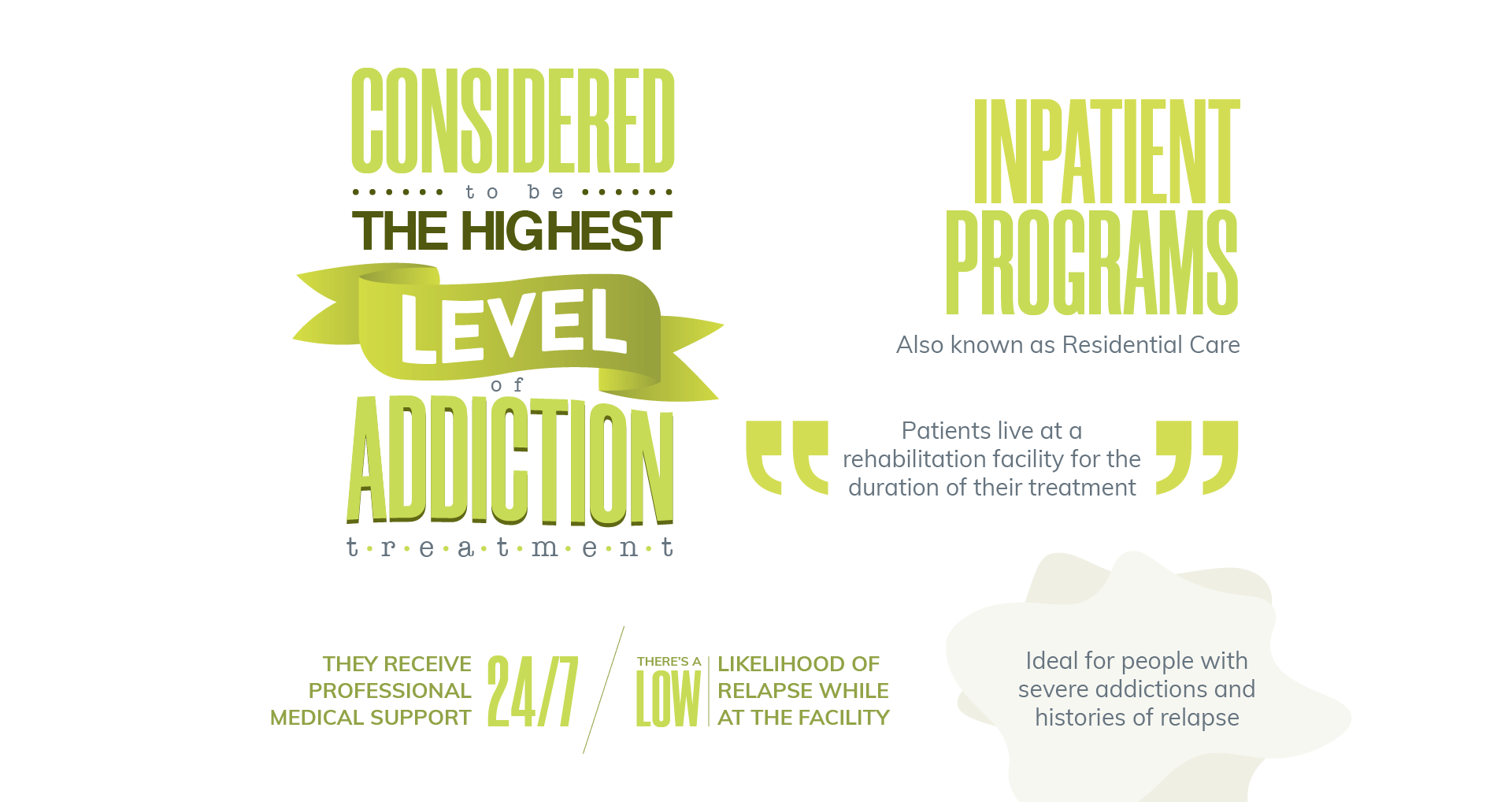
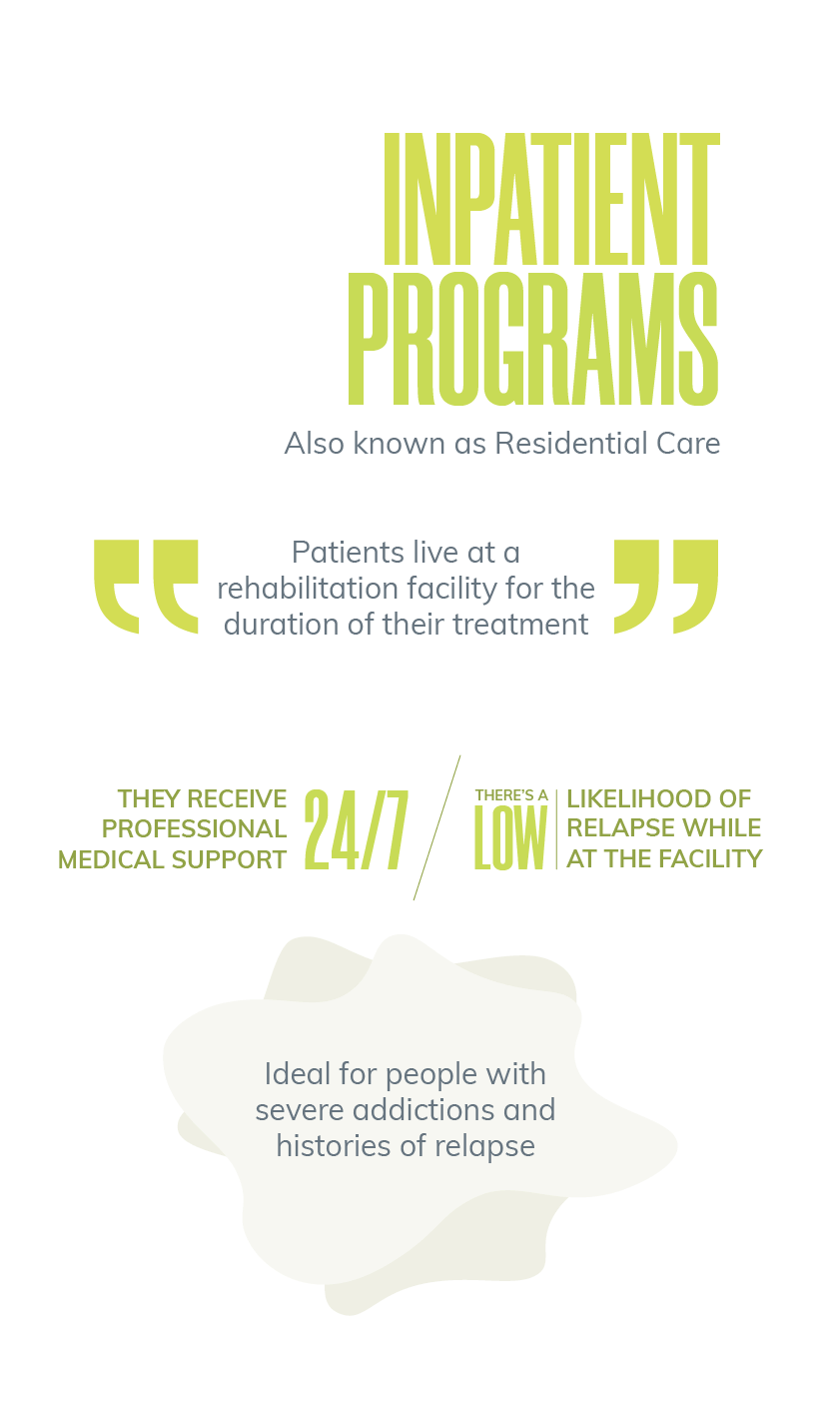
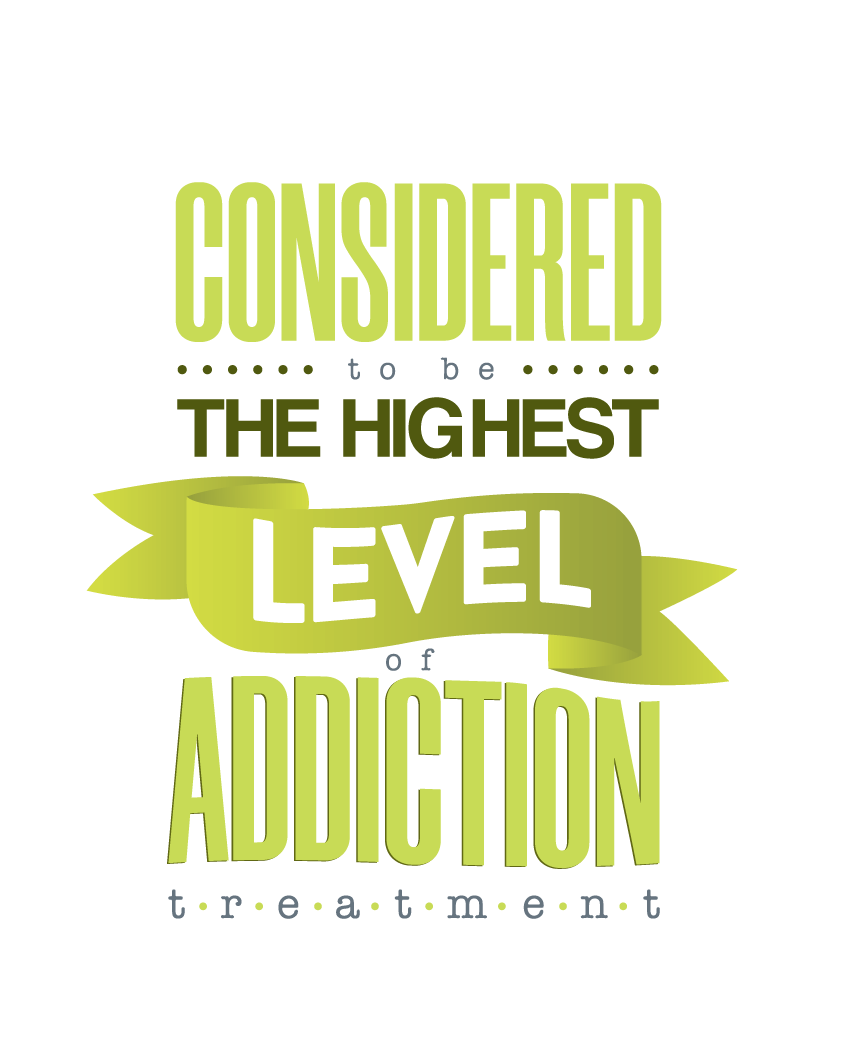
An intensive outpatient program (IOP) is a non-residential addiction treatment program, where recovering post-detox addicts receive both intensive individual and group therapy sessions, as well as educational classes of around 10 hours per week; however, patients get to go home at the end of the day.
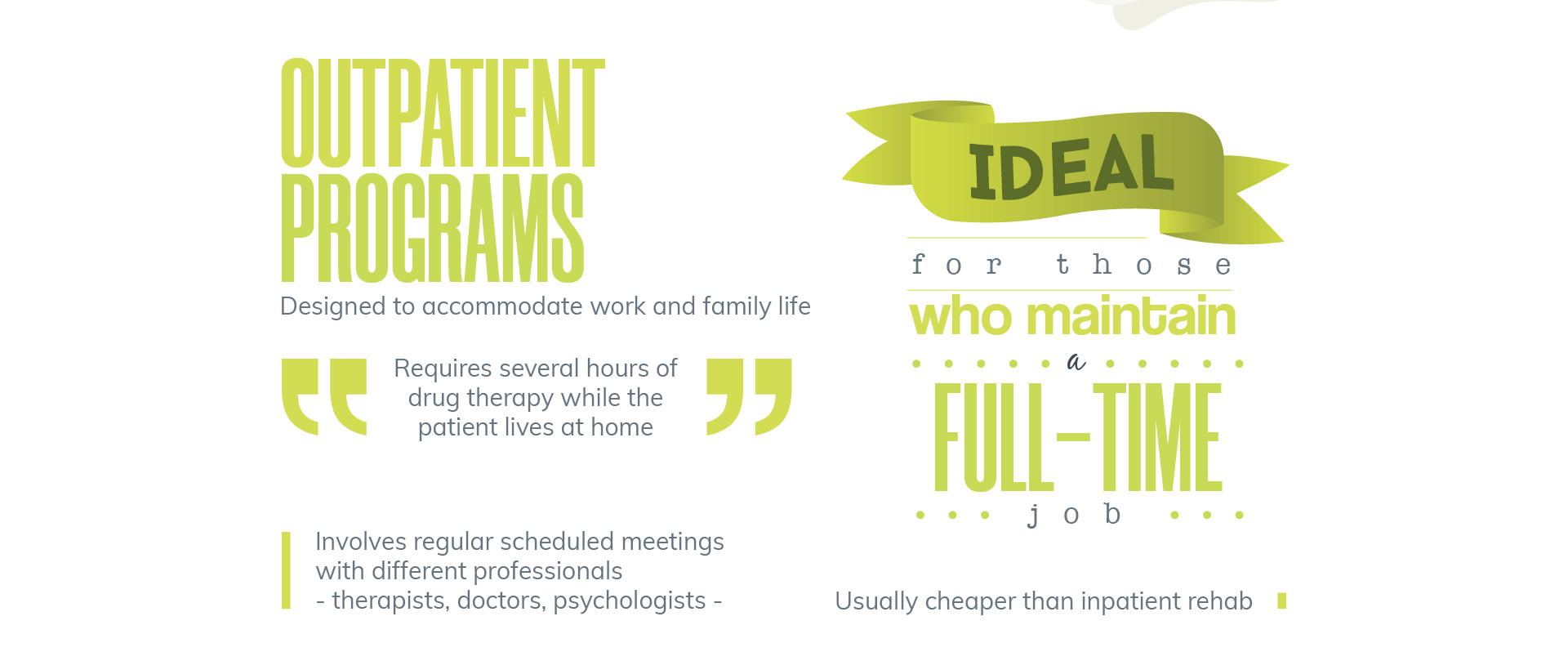
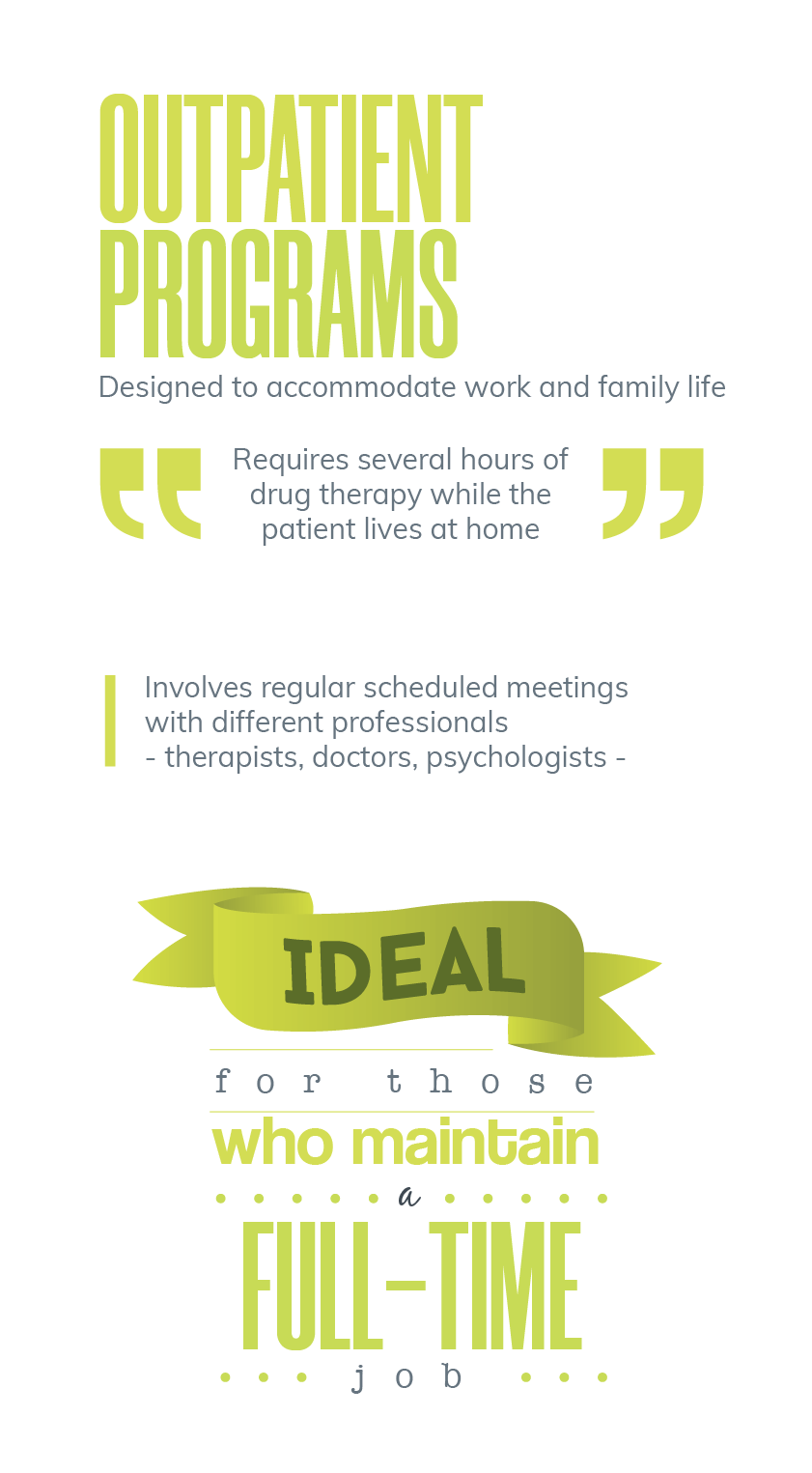
For many people with significant day-to-day responsibilities, IOP can be a more manageable program, and just like inpatient rehab, IOP teaches the necessary relapse prevention methods and coping skills to achieve long-term recovery.
Both drug counseling and therapy normally take place one-on-one with a therapist, although they may involve the use of group sessions with other recovering addicts. During these sessions, the recovering addict and the therapist work together to address specific issues. When individual therapy is combined with craving reduction (the use of naltrexone), those in recovery then benefit from an informed and valuable treatment program, and the true beginning of a healthy and sustained recovery from prescription drug abuse and addiction.

Our admissions coordinators are here to help you get started with treatment the right way. They'll verify your health insurance, help set up travel arrangements, and make sure your transition into treatment is smooth and hassle-free.
888.450.2153Contact Us